
Mastering the Art of Script Writing for Tour Guiding
- Post author:
- Post published:
- Post category: Fiverr
Table of Contents
As a tour guide, you have the power to bring a destination to life and create lasting memories for your audience. And one of the key tools in your arsenal is a well-written script. In this blog, we will explore the various aspects of script writing for tour guiding and how it can elevate your tours to the next level. We will delve into the role of a tour guide, the importance of a well-crafted script, and the impact it has on the overall tour experience. So, whether you are a seasoned tour guide looking to brush up on your skills or a beginner just starting out, this blog is for you.
Researching and Gathering Information:
As a tour guide, it is your responsibility to provide your guests with an informative and engaging experience. This requires thorough research and gathering of information about the destination you will be showcasing.
Conducting thorough research on a destination is crucial in order to provide accurate and up-to-date information to your guests. It also helps you to create a well-rounded and comprehensive tour that covers all the important aspects of the destination. Start by identifying the key attractions, historical sites, and cultural landmarks of the destination. This will give you a framework to work with and ensure that you do not miss any important information. Utilizing different sources for information is essential in order to get a well-rounded understanding of the destination. While guidebooks and online resources are a good starting point, it is important to also explore other sources such as local newspapers, magazines, and blogs. These sources can provide you with insider knowledge and hidden gems that may not be mentioned in mainstream guidebooks. Interviewing locals and experts is another valuable way to gather insider knowledge about the destination. Locals can provide you with personal anecdotes and insights that cannot be found in any book. Experts, such as historians and cultural experts, can provide you with a deeper understanding of the destination’s history and culture. When conducting interviews, it is important to be respectful and ask open-ended questions to encourage the interviewee to share their knowledge and experiences. It is also important to keep in mind that the information you gather may not always be completely accurate. It is your responsibility to fact-check and verify the information from multiple sources to ensure its credibility. This will also help you to avoid any misinformation or outdated information. In addition to gathering information, it is also important to understand the cultural and social norms of the destination. This will help you to avoid any cultural faux pas and ensure that your tour is respectful and inclusive of all guests. Incorporating local language and phrases into your script can also add a personal touch and make the tour more immersive for your guests. This can be achieved through your interactions with locals and through your research on the destination’s language and dialects.
Crafting a Compelling Narrative:
As a tour guide, your main goal is to provide an unforgettable experience for your guests. One of the key elements in achieving this is by crafting a compelling narrative through your script. A well-written script can make all the difference in engaging and captivating your audience, and incorporating historical and cultural context can add depth and authenticity to your tour.
Elements of a Good Story:
Every great tour has a great story at its core. A good story has the power to transport your audience to another time and place, and create an emotional connection with the destination. To craft a compelling narrative, your story should have a clear beginning, middle, and end. It should also have a central theme or message that ties everything together.
Techniques for Engaging and Captivating an Audience:
One of the most important techniques for engaging and captivating an audience is by using descriptive language. Paint a vivid picture with your words, and use sensory details to bring the destination to life. Another effective technique is by incorporating humor and personal anecdotes into your script. This will not only keep your audience entertained, but also make them feel more connected to you as a guide.
Incorporating Historical and Cultural Context into the Script:
Incorporating historical and cultural context into your script is crucial for providing a well-rounded and informative tour experience. This can be done by researching the destination thoroughly and including interesting facts and stories about its history and culture. It’s also important to consider the perspectives of different cultures and present them in a respectful and accurate manner.
Utilizing Visual Aids:
Visual aids can greatly enhance the tour experience and help your audience better understand the destination. Choose visuals that are relevant to your story and use them strategically throughout your tour. This can include photos, maps, videos, and other interactive elements. Just be sure not to rely too heavily on visual aids and remember to still engage with your audience through your words.
Practicing and Refining the Script:
As the saying goes, practice makes perfect. It’s important to rehearse and refine your script before each tour. This will not only help you remember your lines, but also give you the opportunity to make any necessary revisions. Seeking feedback from colleagues or even your audience can also help improve your script and delivery.
Dealing with Challenges:
No matter how well-prepared you are, unexpected challenges may arise during a tour. This could be anything from bad weather to a disruptive guest. As a tour guide, it’s important to stay calm and adapt your script accordingly. This could mean changing the route or adjusting the content to suit the audience. Remember to always remain professional and keep the tour engaging and interactive.
Role of visuals in enhancing the tour experience:
Visual aids can help bring your stories to life and make them more engaging and memorable for your audience. They provide a visual representation of the information you are sharing, making it easier for your guests to understand and retain the information. This is especially important for tours that involve historical or cultural information, as visuals can provide a better context and help guests visualize the past. In addition, visuals can also help break the monotony of a long tour and keep your guests interested and engaged. This is especially useful for tours that involve a lot of walking or traveling, as it gives guests something to look at and focus on while they are on the move.
Choosing the right visuals for different types of tours:
The type of visuals you use will depend on the type of tour you are conducting. For example, if you are leading a nature or wildlife tour, using photographs or videos of the flora and fauna in the area would be more appropriate. On the other hand, for a historical tour, you can use maps, illustrations, or photographs of the historical sites you are discussing. It is important to choose visuals that are relevant to the information you are sharing and are of good quality. Low-quality visuals can be distracting and take away from the overall experience. If you are using photographs, make sure they are clear and well-lit. If you are using videos, ensure they are of high resolution and have good audio quality.
Script Examples for Tour Guiding
Ladies and Gentlemen,
We welcome you to the very heart of this gorgeous city! Hello! My name’s John Your friendly guide throughout the entire day. I’m here to help make your trip as interesting, informative and unforgettable as is possible.
When we embark on our journey Let’s take some time to take in the vast weaving of history, culture and the beauty that makes the place we’re visiting so special.
The first stop on our tour is the stunning”[Insert Name of Landmark],” the place where both history and design blend together seamlessly. It was built in the year [year], this iconic building is a testimony to the rich history of [City’s Name]. When you walk through its halls of grandeur be sure to look at the exquisite details in the walls. Each telling a tale that is unique to it.
After that, we’ll travel toward the lively [Insert Name] Then, we’ll head to the vibrant [Insert Market Name]. It is known for its lively energy, the market has an assortment of products from local vendors including hand-crafted items and mouth-watering street food delight for the entire senses!
The journey takes our group to the peaceful natural site of [Insert Park (or Natural Site NameThis is known as the [Insert Name of Natural Site or Park]. Within the hustle and bustle of city life the park is the tranquility of a retreat. Make sure you take photographs of the amazing panoramas that it provides.
Through our journey I would like to encourage everyone to inquire about your questions, engage with people from the area, and fully immerse yourself in the amazing experience that the city of [City’s Name] can offer. Keep in mind that travel isn’t only about exploring new destinations but also experiencing different flavors, cultures and views.
When we go on our journeys with each other, we must respect the customs and values of our city and leave just footprints, and only take photographs.
We thank you for allowing us to serve to be your guide into the city’s heart. [City’s Name]. Relax, sit back and let’s build memorable memories throughout this incredible trip!
All the best to everyone,
Enjoy this thrilling adventure through breathtaking scenery as well as the captivating tales of our city that we adore. I’m John Your reliable tour guide and your travel companion for this journey.
While we set off on this adventure, let’s take in the beauty and vitality that’s essential to our location.
The first place we visit is the breathtaking [Insert Landmark’s Name], which is a gem that crowns this town. It was built in the year [yearit was completed in the year [Year], its beauty and architectural splendor is a testament to the city’s rich history. When we stroll through its streets, let every stone tell tales from the past.
We’ll then make through the bustling “Insert Name of Market The next step is to visit the bustling [Insert Market Name here]. The market in the city is its center of activity, with a pulsating rhythm and vibrant colors. There’s an abundance of treasures from the local area, tasty food, and cheerful people. Do not be afraid to bargain at times, it’s an element of fun!
Then we’ll retreat in the calm embrace of the [Insert Park or Nature Site Name the name of a park or natural site. The city’s tall buildings are a distant memory the natural oasis offers an oasis of tranquility. Make sure you take some time to take in the stunning views that it provides.
Through our travels I would like to encourage that you share your thoughts as well as ask questions and completely immerse yourself in the journey. It’s as much about people and the culture and traditions as destinations.
Happy day fellow adventurers,
We’re excited to share our journey across the breathtaking views and rich past of this fascinating city. This is my guide today We’ll discover the many stories that make the city so special.
The journey starts at the iconic [insert landmark’s name]. The Landmark’s Name. The architectural wonder, constructed in the year [year], is an emblem of the city’s strength and creativity. When we wander its magnificent halls, each part tells an era that has passed.
We’ll then dive right deep into the center of the city, which is the bustling [Insert Name of Market. It’s a sensory blast of sights, sounds and smells. From hand-crafted crafts to tempting local food, it gives you an insight into the life of our town. Meet the sellers their stories are equally as vibrant as the products they sell!
There, we’ll be able to be able to relax in the peaceful surrounding of the [Insert Park Name or Natural Site Name]. The tranquility of this oasis in bustle of the city is the perfect setting for reflection. Make sure to record beautiful views through your camera and within your minds.
While we travel throughout the city, you are at ease to ask questions, talk about your experiences as you immerse yourself into the culture of the city. Keep in mind that travel involves a collection of experiences not only photographs.
Respecting the city’s heritage as well as the natural environment is essential to the journey we are on. Make sure we don’t leave a footprint behind and preserve its beauty for the next visitors.
We thank you for choosing our company to help you navigate the city’s heart. [City’s Name]. Relax and keep your eyes open and let’s create this adventure a treasure-trove of memories that will last forever!
Hello, esteemed explorers,
Welcome to all in our first foray to the intriguing places and intriguing the history of this fascinating city. Your guide for the day I am able to promise you a rewarding adventure filled with exciting explorations.
The first place we’ll visit today is the legendary [Insert Market Name]. The architectural marvel, built in the year [Year], serves as a resounding representation of our city’s imaginative energy and historic depth. While we wander through its magnificent areas, every corner holds an interesting story to tell and a part of the past to tell.
We’ll then dive into the bustling chaotic city’s center The [Market Name]. The market’s bustling activity is an explosion of colors scents, sounds, and colors. There are a variety of traditional crafts, exotic food and friendly smiles. Get to know the locals. their stories add layers to the story of the city.
After that, we’ll move on towards the serene ambiance of the [Insert Park or [Nature Site Name] Then, we’ll move to the tranquility of [Insert Park or Natural. With the bustle of city life it’s a tranquil oasis that is a welcome respite. Be sure to take in the magnificent views that unfold.
Throughout the trip don’t be afraid to inquire, offer experiences, or immerse yourself within the local culture. It’s all about learning. involves absorbing new perspectives and new perspectives.
While we discover the charm of our city we must remember to cherish the city’s traditions and preserve the natural beauty of its surroundings. Leave only footprints and cherish the precious memories.
Thank you for trusting us to guide you through [Name of the City]. Get ready to be overwhelmed and let’s create a collection of unforgettable memories together!
Welcome to all on our journey through the captivating places and intriguing the history of this fascinating city. As your tour guide today I am able to promise you a rewarding trip filled with wonderful experiences.
The first place we’ll visit today is the famous [Insert Landmark’s Name]. This magnificent structure, which was built in the year of [Year], is regarded as a enduring representation of our city’s artistic spirit as well as its historical profundity. When we walk through its vast spaces, each one has an interesting story to tell, a bit of history that we can share.
We’ll then dive into the bustling urban chaos market, which is the market. [Market Name]. The market’s bustling activity is an awe-inspiring display of scents, colors, and sound. The market is filled with regional crafts, exotic cuisines and friendly smiles. Meet the people who live there, their stories add layers to the story of the city.
After that, we’ll move on into the tranquility of the [Insert Park or Natural Site Name] Then, we’ll move to the tranquility of [Insert Park or Natural. In the midst of the bustling city it’s a tranquil oasis that provides a tranquil respite. Make sure you take time to enjoy the stunning views it offers.
While on our journey don’t be afraid for a chat, impart experiences, or immerse yourself within the local culture. It’s all about learning. is about experiencing new things and new perspectives.
When we explore the charm of our city Let’s not forget to respect the city’s traditions and preserve its beauty and natural splendor. We should leave just footprints and cherish the precious memories.
We thank you for trusting us to guide you through the city of [Name] we are honored to be a part of [City’s Name]. Be ready to be overwhelmed and let’s create a collection of memorable moments!
Intrepid travelers, greetings!
Begin our adventure through breathtaking landscapes and the fascinating tradition of this amazing city. As your tour guide I’m thrilled to join you on this journey filled with fascinating insights.
The journey begins with the magnificent insert landmark’s name of the Landmark. It was built in the year of year this awe-inspiring building is an example of the city’s creative talent and the strength of its past. When we travel its long avenues, every intricate element is a relic of past times.
Then we head to the bustling heart of the city. It’s the lively [Insert Name of Market]. The bustling marketplace offers a variety of hues scents, sounds, and colors. From handmade souvenirs to delectable local food, it offers an authentic glimpse of the city’s life. Do not be afraid to interact with locals, their stories add an interesting color to the story of the city.
We then retreat in the calming surroundings in [Insert Park or Nature Site Name]. In the midst of a city’s constant tempo it is a tranquil spot that provides a respite. Take time to take in the breathtaking views which open up in front of your eye.
While we travel, you are welcome to ask questions, discuss your experiences as you immerse yourself within the culture and ethos of the city. Travel is, after all, an opportunity to gather experiences, not merely snaps.
While we weave the fascinating tapestry of our city we must pledge to respect its traditions and preserve its stunning beauty. We must ensure that our footprints remain only temporary, yet our memories last forever.
We thank you for trusting us with your exploration of the city’s name. Get ready for a thrilling trip and let’s create the most unforgettable memories!
Hello, adventurous souls,
Enjoy our thrilling journey through the fascinating corners of this amazing city. Your tour guide is me I’m thrilled to guide you on an adventure that is filled with amazing sites and treasures from the past.
The first stop is the stunning [Insert Landmark’s Name]. It was built in [year] the building represents our city’s culture as well as its long and rich heritage. When we stroll through its sprawling halls, every corner and cranny tells an intriguing tale from the past.
We’ll then explore the vibrant heart of the city: the bustling marketplace named [Insert Market Name]. This lively market provides a visual explosion of smells, colors and sound. There is a variety of traditional products, delicious cuisines and smiling faces. You are welcome to interact with the vendors in town and their stories add a personal element to the story of the city.
We’ll then move into the serene setting of [insert Park or Nature Site Name], Then, we’ll move to the tranquil setting of [Insert Park or Natural. Within the hustle and bustle of city life it offers an opportunity to enjoy a quiet moment. Do not forget to enjoy the breathtaking views it provides.
While we travel I would like to encourage people to inquire to share your thoughts, offer insights as well as fully enjoy the unique atmosphere of your city. It’s true that traveling involves soaking oneself in different perspectives and experiences.
While we explore the charm of the city we must remember to honor its customs and safeguard the beauty of nature. We must ensure that we leave just footprints and bring back an incredible collection of treasures.
We thank you for choosing to join us in exploring the city of [City’s Name]. Make sure you buckle up to embark on an exciting journey in creating an album of memorable moments with you!
Tips for creating visually appealing and informative presentations:
Keep it simple: Avoid cluttering your presentation with too much information or too many visuals. This can overwhelm your audience and make it difficult for them to focus on the key points. Use a variety of visuals: Mix it up by using a combination of photographs, videos, maps, and illustrations. This will keep your audience engaged and prevent them from getting bored. Use captions and labels: Make sure to label your visuals with relevant information, such as the location or date of a photograph. This will provide context and make it easier for your guests to understand. Use storytelling techniques: Just like your script, your visuals should also tell a story. Use techniques such as before and after photos or a series of images to create a narrative. Incorporate humor: Visuals can also be used to inject some humor into your presentation. This can help lighten the mood and make the tour more enjoyable for your guests.
Use technology: There are many tools and software available that can help you create visually appealing presentations. Practice and rehearse: Just like your script, it is important to practice and rehearse your presentation to ensure a smooth and seamless delivery.
As a tour guide, your script is your most valuable tool. It sets the tone for the entire tour and acts as a guide for both you and your audience. A well-written and practiced script can make the difference between a mediocre tour and an unforgettable experience for your guests.
Importance of Rehearsing and Practicing the Script:
Rehearsing and practicing your script is crucial for delivering a smooth and engaging tour. It allows you to become familiar with the content, flow, and timing of your script. By rehearsing, you can also identify any areas that may need improvement or clarification. Practicing your script also helps you to become more confident in your delivery. Nerves and stage fright can be common for tour guides, especially when leading a large group. However, by rehearsing and practicing your script, you become more comfortable with the material, making it easier to deliver it with confidence and enthusiasm.
Seeking Feedback and Making Necessary Revisions:
While practicing your script, it is important to seek feedback from others. This can be from colleagues, friends, or even your guests. Their perspectives can provide valuable insights and help you identify any areas that may need improvement. As you receive feedback, be open to making necessary revisions to your script. Remember, your goal is to provide the best possible experience for your guests, and their feedback can help you achieve that. It is also important to keep in mind that your script should be a living document, constantly evolving and improving with each tour.
Incorporating Improvisation Techniques for a More Natural Delivery:
No matter how well-rehearsed and practiced your script is, there may be moments during a tour that require some improvisation. This could be due to unexpected situations, questions from guests, or simply wanting to add a personal touch to your delivery. Incorporating improvisation techniques into your script can make your tour feel more natural and authentic. It allows you to connect with your audience on a more personal level and make the tour experience more engaging and interactive. Some improvisation techniques you can use include storytelling, humor, and asking open-ended questions to encourage participation from your guests. Remember to always stay true to the main points of your script, but don’t be afraid to add your own personal flair to keep things interesting.
As a tour guide, you are responsible for creating a memorable and informative experience for your guests. However, despite thorough planning and preparation, unexpected situations can arise during a tour that can throw off your script and disrupt the flow of your tour. These challenges can range from weather changes to technical difficulties, and even difficult guests. As a professional tour guide, it is crucial to have strategies in place for handling these challenges and adapting your script to different audiences to ensure an engaging and interactive tour. Handling unexpected situations during a tour requires quick thinking and flexibility. The first step is to remain calm and composed, as your guests will look to you for guidance. For example, if the weather suddenly changes, you may need to adjust the route or find an indoor alternative. If there are technical difficulties, have a backup plan in place, such as using a different device or switching to a different activity. It is also essential to communicate openly and honestly with your guests, keeping them informed of any changes and reassuring them that their experience will not be compromised. Another challenge that tour guides face is adapting their script to different audiences. Each group of guests is unique, with varying interests, knowledge levels, and cultural backgrounds. It is crucial to research and understand your audience beforehand to tailor your script accordingly. For example, if you have a group of history buffs, you may want to go into more detail about the historical significance of a location. On the other hand, if you have families with young children, you may want to incorporate fun facts and interactive activities to keep them engaged. To adapt your script effectively, it is essential to have a broad knowledge of the destination and its history, culture, and customs. This will allow you to make on-the-spot changes and additions to your script to cater to your audience’s interests. Additionally, be open to feedback from your guests. They may have specific questions or interests that you can incorporate into your script to make it more relevant and engaging for them. Keeping the tour engaging and interactive is crucial for a successful experience. A well-written script is a great starting point, but it is essential to keep your guests actively involved throughout the tour. One way to do this is by incorporating interactive elements such as quizzes, games, or hands-on activities. This will not only keep your guests engaged but also make the information more memorable for them. Another tip for keeping the tour interactive is to engage your guests in conversations and encourage them to ask questions. This will make the tour more personal and allow for a deeper understanding of the destination. Additionally, make use of visual aids such as maps, photos, and videos to enhance the tour experience and keep your guests visually engaged.
Conclusion:
In conclusion, mastering the art of script writing for tour guiding is a crucial skill for any tour guide looking to provide an exceptional experience for their guests. Throughout this blog, we have explored the various aspects of script writing and how it can greatly enhance the overall tour experience. We began by understanding the role of a tour guide and the importance they hold in the tourism industry. We then delved into the responsibilities and qualities of a successful tour guide, highlighting the impact of a well-written script on the overall tour experience.
Make Accurate Predictions with Script for Weather Forecast
Unlocking the Power of Script for Emcee
You Might Also Like

Data Entry Description For Fiverr

How To Get Fast Order On Fiverr


How to Write a Tour Guide Script Perfectly in 2024 (Craft Engaging Narratives!)
- Blog , Digital Nomad Travel Guide
- January 2, 2024

To write a tour guide script, identify key attractions, and weave in engaging stories. Highlight facts that captivate and entertain your audience, keeping them intrigued throughout the tour.
How to Write a Tour Guide Script perfectly? A tour guide script is the backbone of any memorable and educational guided tour. Crafting a script requires a balance of historical data, interesting anecdotes, and practical information. It should be engaging, offering unique insights that intrigue your audience and provide a deeper connection to the sights.
A successful tour guide script is not just a monologue but a conversational tool to interact with your audience and enhance their touring experience. It’s crucial to tailor your content to your specific audience, ensuring clarity and relevance. The goal is to leave your tour-goers with lasting impressions and newfound knowledge about the places they’re exploring. Remember, a well-crafted script is the key to making any trip both enjoyable and informative.
KEY TAKEAWAYS
- Engage Your Audience from the Start: The importance of a compelling opening hook was emphasized. Drawing in your audience from the very beginning is crucial to capture their attention and set the tone for an engaging tour. This could involve a fascinating fact, a thought-provoking question, or a captivating anecdote related to the tour destination.
- Blend Information with Storytelling: From early on, try how to effectively weave information seamlessly into storytelling. Rather than presenting a dry list of facts, the recommendation is to integrate historical details, anecdotes, and intriguing facts into a cohesive narrative. This approach not only educates the audience but also entertains and keeps them enthralled throughout the tour.
- Encourage Reflection and Interaction: Incorporate moments for reflection and audience interaction throughout the tour. Pose thought-provoking questions and invite participants to engage actively with the content. This not only enhances the educational aspect of the tour but also fosters a dynamic and participatory experience. Such an approach allows tour attendees to connect more deeply with the subject matter, making the entire tour more memorable and enjoyable.
Table of Contents
What Is A Tour Guide Script?

Embarking on an unforgettable journey requires more than just a keen sense of direction; it demands a captivating narrative to guide the way. A tour guide script plays a pivotal role by being the very crux of this narrative, paving the path for explorers through a blend of storytelling and factual information.
Tour guide scripts are meticulously crafted pieces of writing designed to enrich the touring experience for guests. They serve multiple purposes:
- Instructional roadmap: It outlines the tour’s structure, guiding the guide through each segment and transition smoothly.
- Engaging storytelling tool: The script contains fascinating tales and anecdotes about the places visited, ensuring an engaging and memorable experience.
- Educational resource: By delving into historical, cultural, or natural insights, the script educates and informs the audience.
- Interpersonal connector: It prompts interaction with the audience, encouraging questions and discussions.
A well-composed script transforms a mundane outing into an educational adventure, leaving tourists with lasting memories and insights into the visited landmarks. Consider a tour guide script as the backbone of the tour, supporting a seamless integration of fun facts, navigation, and interaction that all contribute to a successful and spellbinding tour.
Tour Guide Script Opening Remarks

Crafting A Captivating Beginning For Tour Guide Scripts
Crafting the perfect opening remarks for a tour guide script is akin to setting the stage for an enthralling performance. The initial words that emerge from the guide’s mouth can either spark the audience’s interest or fail to captivate them.
Therefore, it’s critical to start strong with remarks that are both welcoming and hint at the exciting journey ahead.
Incorporate Local Greetings
Starting a script with a touch of local flavor can immediately draw your audience in and show cultural immersion:
- Local greeting: Use a common greeting from the tour’s area to create a sense of place.
- Acknowledge return visitors: Express pleasure for repeat guests, signaling that the experience is worth revisiting.
Share An Intriguing Fact Or Story
Kicking things off with an interesting tidbit can pique curiosity and set the tone for the tour:
- Share a secret: Begin with an unknown or little-known fact about the location to entice your audience.
- Tell a short story: Relay a brief anecdote that ties into the tour’s theme or destination, providing a narrative hook for listeners to latch onto.
Outline Expectations Clearly
It’s essential to manage your audience’s expectations from the get-go for a smoother experience:
- Duration of the tour: Clearly stating the tour length helps guests gauge their time commitment.
- Key attractions: Preview some highlights to build anticipation for the sights and experiences on the itinerary.
Emphasize Engagement And Interaction
Encourage your guests to interact and engage with the tour, ensuring a memorable and dynamic experience:
- Promote questions: Invite the crowd to ask questions at any time, fostering a two-way dialogue.
- Suggest participation: Let guests know their involvement is not only allowed but encouraged, whether it’s trying something hands-on or sharing their insights.
Communicate Essential Safety Information
Safety must always be a priority, so make sure your audience knows what to do in case of an emergency:
- Point out safety features: Briefly note the location of exits, first-aid kits, or life vests.
- Cover basic safety rules: Include any necessary guidelines applicable to the tour to prevent accidents and ensure collective well-being.
By incorporating these elements into your opening remarks, you set the stage for an informative, enjoyable, and smoothly run tour that will keep your audience captivated from start to finish. Remember, the goal is to blend education with entertainment seamlessly—forge a connection, earn trust, and most importantly, leave your guests eager for the adventures that lie ahead.
Become A Confident Public Speaker

1. Embrace Your Unique Voice
As a tour guide, your voice is your most valuable asset. Projecting confidence begins with accepting and leveraging the unique qualities that make you stand out. Embrace your tone, cadence, and accent, as these are part of what makes each tour distinctly yours.
2. Practice Makes Perfect
The path to public speaking confidence is paved with practice. Regularly rehearsing your script aloud will:
- Improve diction: Speaking is vital for keeping your audience engaged.
- Assist with pacing: The flow of your speech affects the audience’s ability to absorb information.
- Build familiarity: The more you rehearse, the more natural the content will feel, reducing the need for constant script-checking.
3. Engage With Your Audience
Creating a connection with your audience can transform your script from monologue to dialogue:
- Eye contact: This establishes a personal connection and can help gauge the audience’s interest and understanding.
- Responsiveness: Adapt to audience reactions and questions to make the experience more interactive.
4. Incorporate Storytelling Techniques
Storytelling can elevate a factual guide into an enthralling narrative:
- Set the scene: Paint a vivid picture of each location to immerse your audience fully.
- Use anecdotes: Personal or historical stories related to the tour sites can make the information more relatable and memorable.
5. Maintain Positive Body Language
Confidence is as much about what you say as how you say it:
- Posture: Standing tall conveys authority and can positively affect your vocal projection.
- Gestures: Appropriate hand movements can emphasize points and make your delivery more dynamic.
6. Continue Learning
As with any skill, staying informed and educated is crucial for growth:
- Stay updated on public speaking techniques: New methods can revitalize your approach and effectiveness.
- Learn from others: Attend other tours to observe different styles and incorporate elements that resonate with you.
By following these practical steps and consistently honing your public-speaking prowess, your tour guide scripts will not only inform but also delight and inspire your audience, leaving a lasting impression long after the tour ends.
How To Make A Good Commentary In Tour Guiding?

Below, let’s explore how to create a commentary that transforms a simple excursion into a memorable adventure.
Understand Your Audience
Before diving into scriptwriting, take a moment to think about your audience. Are they history buffs, adventure seekers, families with children, or a mix of everyone? A good commentary should cater to the interests of your group:
- Audience analysis: Identify the demographics, interests, and knowledge level of your tour group.
- Tailoring content: Adjust your script to include information that resonates with these interests.
- Engage personally: Add personal touches or address the group in a way that makes them feel included in the narration.
Keep It Relevant And Accurate
Your script should be a treasure trove of facts and anecdotes that pertain to the locations you are touring. Here’s how you can make it educational and entertaining:
- Reliability: Double-check all historical facts, dates, and figures to establish credibility.
- Relevance: Connect your commentary to the location’s significance or events that capture the essence of the place.
- Anecdotes: Include short stories or interesting tidbits that stick with the audience and enrich the experience.
Mix Humor With Information
A great tour guide script delicately balances educational content with a light-hearted tone. The incorporation of humor makes the tour more enjoyable and less monotonous:
- Light humor: Introduce jokes or funny observations that relate to the sightseeing points without overshadowing the informational content.
- Timing: Know when to use humor effectively, especially after a heavy dose of history or facts to lighten the mood.
Utilize Storytelling Techniques
Weaving a story around the facts makes the commentary not just informative but memorable. This technique allows you to connect with the tour group on an emotional level, guiding them through a historical or cultural journey:
- Chronological flow: Arrange events or information in a logical sequence to maintain clarity.
- Vivid descriptions: Paint a picture with words to make locations come alive in the imagination of your listeners.
Engage With Interactive Elements
It’s not just about what you say, it’s also about how you encourage participation:
- Questions: Ask open-ended questions that provoke thought and encourage interaction.
- Activities: Include pauses where attendees can engage with the environment or participate in brief activities related to the tour.
Plan For The Unexpected
Tours don’t always go according to plan. Here’s how you can stay ahead:
- Flexibility: Have additional material or alternative routes ready in case of unforeseen circumstances.
- Problem-solving: Be prepared to smoothly transition your script to adapt to changes.
Remember, every word and phrase in your script weaves a larger picture, setting the stage for an unforgettable journey. Embrace these strategies, and you’ll be well on your way to crafting a tour guide commentary that is as engaging as it is informative.
Researching The Destination
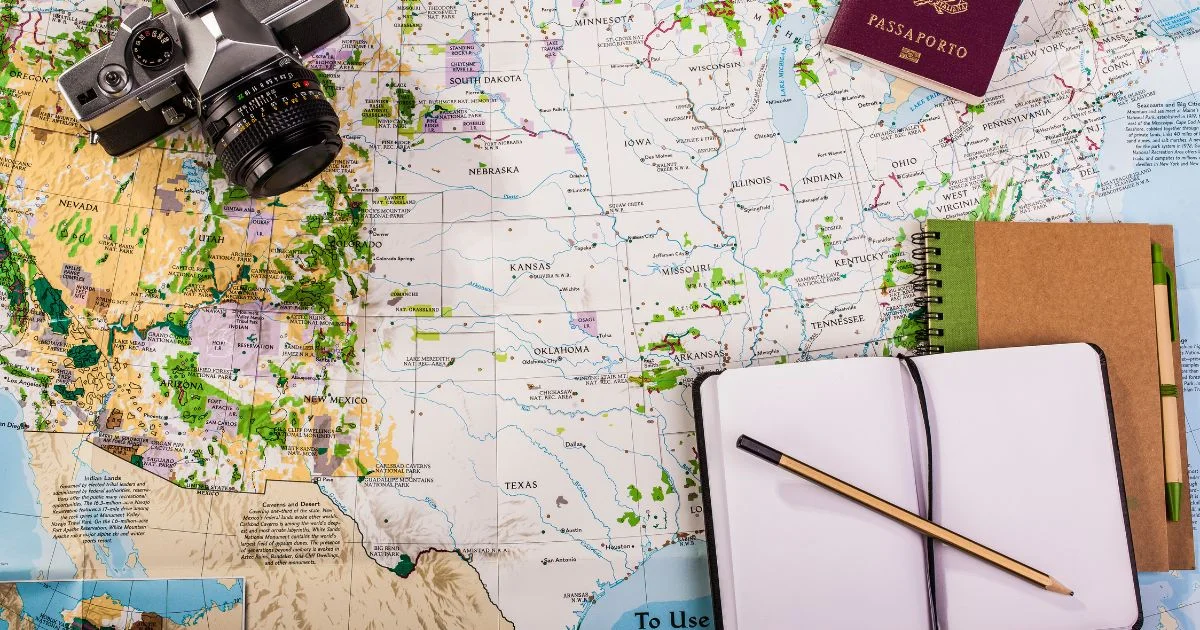
Understand The Historical Context
The true essence of a place is often rooted in its history. Embarking on a journey through a destination’s past can provide invaluable insights for a compelling tour guide script:
- Research the founding dates and key events: This lays a historical timeline for your narrative.
- Identify significant figures: Historical personalities can add vividness to your storytelling.
- Explore local myths and legends: These can captivate and intrigue your audience, adding a mystical layer to the factual history.
Delve Into Current Cultural Practices
To paint a complete picture, it’s crucial to intertwine the past with the present. Tourists are often just as interested in current customs as they are in ancient tales.
- Investigate local festivals and events: Knowing local celebrations can descriptively showcase the community’s spirit.
- Understand dietary customs: Food is a profound reflection of cultural identity and can be a savory detail in your script.
- Recognize contemporary art and music: These elements underscore the modern vibe of a place, connecting the past to the present.
Highlight Noteworthy Landmarks
Tourists are visually oriented, seeking the spectacular sites that give a place its postcard-worthy status. Dive into the architectural wonders and natural sceneries that define your location. This is where you can turn descriptions into experiences, invoking the grandeur of man-made edifices or the serene whisper of a rolling landscape.
Gather Local Stories And Anecdotes
A place’s heartbeat is often felt in the stories of its inhabitants. Collecting anecdotes can give your script a personable touch that aligns perfectly with the sightseeing experience:
- Talk to residents: Their personal experiences can provide unique and engaging content for your script.
- Read local literature: Novels, poems, and articles can offer a treasure trove of inspiration and authentic material for your narrative.
- Follow community social media groups: They can be goldmines for the latest buzz and little-known facts about your destination.
In weaving together your research, ensure that your script resonates with the enthusiastic pulse of eager explorers. Let your words be their guide through time, culture, and the marvels of the destination; transforming each step into a discovery and each view into a lasting memory.
Understanding The Target Audience

Identifying Demographics
Demographics provide insight into the age, nationality, and cultural background of your audience:
- Age range: This influences the complexity of language and the choice of stories.
- Nationality: Being aware of where your audience comes from can help you include relevant cultural references or explain local customs in a relatable way.
- Cultural interests: Understanding whether your audience prefers art, architecture, history, or nature helps tailor the content of your tour.
Through this understanding, you can shape a script that resonates with your audience, making your tour not only informative but also deeply engaging.
Recognizing The Visitor’s Purpose
People take tours for various reasons. Identifying these can vastly improve the script’s relevance:
- Educational objective: Is the tour part of a study trip? Incorporate more detailed historical data and analysis.
- Leisure and relaxation: For those seeking enjoyment, prioritize captivating stories and lighter, entertaining content.
- Specialized interest: Cater to enthusiasts by delving into niche topics such as local gastronomy or architectural styles.
Assessing Prior Knowledge
Being mindful of the audience’s existing familiarity with the toured area contributes to a well-paced and informative experience:
- First-time visitors: Explain the context and basic information more thoroughly.
- Repeat visitors: Focus on lesser-known facts or unique perspectives that deepen their understanding.
Remember, the best tour guide script is one where the audience feels seen, understood, and considered throughout the journey. This way, you create not just a tour, but a memorable adventure for every participant.
Structuring The Script For Maximum Impact

Let’s delve into how you can structure your script to achieve a seamless storytelling experience in 6 easy steps:
1. Beginning With A Bang
Starting strong sets the tone for the rest of your tour. Your opening remarks should be:
- Compelling: Draw in your audience with an intriguing fact or question.
- Relevant: Ensure it relates to the theme and purpose of the tour.
- Brief: Keep it concise to maintain interest and curiosity.
2. Dividing Your Content
Your tour script should flow naturally from one segment to the next, like chapters in a book. To accomplish this:
- Organize logically: Arrange points in an order that makes sense geographically or thematically.
- Pace evenly: Divide content so that each part is given appropriate time.
- Transition smoothly: Use connecting sentences to seamlessly move from one point to another.
3. Emphasizing Key Points
Within the body of your script, highlight the must-know details:
- Significance: Explain why certain facts or sites are noteworthy.
- Clarity: Present information clearly and avoid jargon that may confuse visitors.
- Engagement: Pose questions or invite participation to keep the audience involved.
4. Wrapping Up With A Memorable Close
Conclude your script on a high note by ensuring:
- Reflection: Encourage the audience to think back on the experience.
- Summary: Recap the key themes or highlights of the tour.
- Call to action: Suggest further reading, places to visit, or encourage feedback.
5. Pacing Your Information Delivery For Audience Retention
A well-paced script is the key to keeping your audience engaged throughout the tour. Overloading listeners with information can lead to disconnect, while too little may cause them to lose interest. Think of your script as a symphony with variations in tempo . Arrange your content to alternate between storytelling, facts, and pauses, where the audience can absorb the sights and sounds around them.
- Introduce a captivating story.
- Follow with intriguing facts or history.
- Pause to allow reflection and observation.
- Resume with anecdotes or lesser-known tidbits.
- Encourage questions and discussions.
6. Incorporating Interactive Elements Into Your Narrative
Interactivity transforms a monologue into a dialogue, fostering a more dynamic and memorable experience. Consider incorporating interactive elements such as Q&A sessions , scavenger hunts , or role-playing activities to immerse your audience in the narrative. A simple, “Can anyone guess the reason behind this building’s unusual shape?” can spur participation and investment in the tour’s storyline.
Crafting an effective tour guide script requires thoughtfulness in structure and content. Through the careful organization of your script, punctuated with engaging and significant facts, you’re setting the stage for an unforgettable experience for your audience. Keep it concise, keep it lively, and watch as your words bring the life journey.
Writing Techniques You Can Follow for Maximizing Output

Paint Pictures With Words
- Vivid descriptions: Bring locations to life with descriptive language that appeals to the senses. Imagine you’re creating a scene in a novel.
- Storytelling: Weave historical facts with anecdotes to captivate your listeners. A personal touch can make history feel relevant and intriguing.
Incorporate Interactive Elements
Tour experiences become more enriching when the audience is involved. Utilize these techniques:
- Questions to ponder: Pose thought-provoking questions that encourage reflection on the visited sites.
- Activities: Brief, relevant activities can break up the script and maintain engagement. For example, asking the group to imagine themselves in a historical moment.
Keep It Structured
Every word counts in a script where attention spans are limited. Organize your content to ensure clarity and logical flow. Highlight the key points you want the audience to take away, and transition smoothly between topics to keep the narrative engaging.
Use Humor Wisely
- Relatability: Humor helps connect with the audience, but it’s crucial to be sensitive to cultural differences.
- Timing: Strategic placement of light-hearted comments can enhance enjoyment but be aware of the context in which you use them.
Precision And Brevity
Keeping it Precise and Concise is vital. Here are some of the ways you can do that:
- Stay on topic: Avoid meandering narratives that can cause a loss of interest.
- Simple language: Opt for direct, straightforward sentences that are easy to follow while walking and absorbing the surroundings.
Remember, your script is the bridge between the audience and the world you’re describing. It is both an educational tool and an entertainment source. Keep your voice natural, as if you’re conversing with a friend, for a truly immersive experience.
Closing Tour Guide Script

Engage With A Personal Touch
- Thank you for joining us:
Express genuine gratitude toward your audience for choosing your tour and spending their time with you.
- Share a personal story or favorite moment:
Conclude with an anecdote that ties back to the journey, reinforcing a personal connection and making the closing remarks more relatable.
Encourage Further Exploration
- Suggest related places of interest:
Recommend nearby attractions or hidden gems that guests could explore on their own to continue their adventure.
- Offer materials for additional information:
Provide pamphlets, website links, or social media handles that direct guests to more resources about the sights they’ve seen.
Seal It With A Call To Action
Creating an effective call to action can help maintain the connection between you and your guests long after the tour ends. Encourage them to share their experience through social media, write a review, or sign up for future tours. This not only promotes your service but also fosters a community of enthusiastic travelers.
Parting Words Of Thanks
- Reiterate your thanks:
A final thank you reaffirms the value you place on your guests’ choice to spend their day with you.
- Wish them well on their journey:
Send them off with warm wishes for the rest of their travels, highlighting your role as both a guide and a goodwill ambassador.
As your group prepares to disperse, remind them of the incredible journey you’ve shared, and let them know that their presence made the tour that much more special. With these tips in mind, your closing script will not only echo in their memories but will encourage them to dive deeper into the wonders they’ve just discovered.
Practical Tips for Writing A Perfect Tour Guide Script

1. Research Thoroughly
Immersing your listeners in the experience requires more than just skimming the surface:
- Historical accuracy: Ensure every historical reference is double-checked for accuracy to build trust with your audience.
- Local color: Dig for those quirky facts and lesser-known stories that give a place its unique flavor and charm.
2. Keep It Interactive
Avoid monologues; encourage participation to keep your audience engaged:
- Questions and prompts: Spark curiosity by asking questions or encouraging them to guess what’s next.
- Physical involvement: Allow them to touch, feel, or perform actions when appropriate to create a multisensory experience.
3. Balance Information With Entertainment
A good tour guide script educates while it entertains; here’s how to strike that balance:
- A mix of facts and stories: Blend historical accounts with anecdotes to keep the information digestible and exciting.
- Humor: A dash of light-heartedness can make a tour memorable but use it judiciously according to your audience’s tastes.
4. Script Structure Is Key
An organized script ensures a smooth tour flow:
- Chronological order: If possible, structure your narrative to follow a logical timeline that’s easy to follow.
- Clear transitions: Guide your group from one topic to the next with smooth segues to maintain continuity and interest.
5. Practice Pacing
The rhythm of your delivery can have a significant impact:
- Variety in tone: Use changes in pitch and pace to highlight different points, creating a dynamic audio experience.
- Pauses: Employ short pauses to let important information sink in or to build suspense before revealing an interesting fact.
6. Language And Word Choice
Selecting the right words can paint a vivid picture:
- Descriptive language: Enliven your script with descriptive language that helps your audience visualize the scene.
- Simple terminology: Choose words that are easily understandable to avoid alienating listeners who may not be familiar with complex jargon.
7. Understand Your Audience
Take a moment to consider who will be listening to your script:
- Audience demographics: Tailor your language and content to the age, interests, and cultural background of your audience.
- Audience knowledge: Gauge their familiarity with the subject to provide information that enlightens, but doesn’t overwhelm or bore.
8. Final Touches
Before the premiere of your tour, some finishing touches are needed:
- Rehearse out loud: This can help you catch any tongue-twisters or awkward phrasing.
- Seek feedback: Share your script with a trusted colleague or friend to get a fresh perspective and constructive criticism.
By following these practical tips, you will craft a tour guide script that not just informs, but also inspires and entertains. Remember that the most extraordinary tours are those where the guide’s passion for the subject shines through every word.
Example Of A Tour Guide Script

Good day, intrepid explorers! Welcome to the land where history whispers through the winds and the sands tell tales of ancient wonders. I’m [Your Name], your guide on this extraordinary journey, as we stand in the shadow of a marvel that has withstood the test of time – the Great Pyramid of Giza!
As we gather here today, envision a time when pharaohs ruled and colossal monuments rose from Egyptian soil. The Great Pyramid, also known as the Pyramid of Khufu, stands as a testament to the ingenuity of the ancient Egyptians. But let’s not get ahead of ourselves. Before we dive into the wonders of this colossal structure, let’s take a moment to soak in the atmosphere and appreciate the magnitude of what lies before us.
[Cultural Introduction]
Let’s start with a local greeting, “Ahlan wa sahlan!” (Welcome!) Egypt, a land where the past and present coexist harmoniously, beckons you to explore its mysteries. And what better way to embark on this adventure than by unraveling the enigma of the Great Pyramid?
Now, my fellow adventurers, how many of you have ever dreamt of standing in front of this colossal structure, pondering the secrets it guards? Today, your dreams become reality as we delve into the heart of ancient Egypt, a civilization that left an indelible mark on the annals of human history.
[History Unveiled]
Our story begins over 4,500 years ago, in the Fourth Dynasty of the Old Kingdom, with the Pharaoh Khufu. Imagine, if you will, a bustling construction site where thousands of laborers, skilled craftsmen, and architects collaborated to build what would become one of the Seven Wonders of the Ancient World.
Now, why did they embark on this colossal project? Was it merely a display of power, or did it hold a more profound purpose? The Great Pyramid was not just a tomb for Pharaoh Khufu but a celestial pathway to the afterlife, a testament to the ancient Egyptians’ belief in the divine journey beyond the earthly realm.
As we stand here, let your imagination wander back to the time when the Great Pyramid gleamed, covered in smooth, white Tura limestone casing stones, reflecting the sun’s brilliance like a dazzling jewel against the golden Egyptian sky.
[Intriguing Facts]
Let’s sprinkle our journey with some fascinating facts about this architectural marvel. Did you know that the Great Pyramid was originally 146.6 meters tall but has slightly diminished over time? Even so, its towering presence remains awe-inspiring, standing as the tallest of the original Seven Wonders of the World.
Consider this – the Great Pyramid was constructed with an estimated 2.3 million blocks of limestone and granite, each weighing several tons. How on earth did the ancient Egyptians transport and position these colossal stones with such precision? That, my friends, is a question that still intrigues archaeologists and Egyptologists today.
And here’s a little puzzle for you: Can you guess how many chambers are concealed within the heart of the pyramid? Well, not to keep you in suspense – there are three primary chambers: the King’s Chamber, the Queen’s Chamber, and an underground chamber. Each holds its secrets, and we’ll explore them in due course.
[Questions and Reflection]
Now, let’s pause for a moment of reflection. Imagine you’re an ancient Egyptian gazing upon the Great Pyramid for the first time. What thoughts might be swirling in your mind? How would the sheer magnitude of this structure inspire awe and wonder?
Consider the symbolism embedded in every block, the meticulous alignment with the cardinal points of the compass, and the reverence for celestial bodies. As you ponder these questions, you start to grasp the layers of meaning woven into the very fabric of this monumental creation.
[Exploring the Chambers]
Our journey continues as we venture inside the Great Pyramid, stepping into the sacred spaces that have guarded the mysteries of millennia. As we enter the grand gallery leading to the King’s Chamber, imagine the echoing footsteps of priests, the flickering light of torches, and the anticipation of reaching the heart of the pyramid.
The King’s Chamber, with its granite sarcophagus, sparks countless debates among scholars. Was it truly the final resting place of Pharaoh Khufu, or does it conceal a deeper cosmic significance? Take a moment to absorb the resonance of this sacred space, where ancient rituals and ceremonies unfolded.
[Anecdotes and Mysteries]
Let me share a captivating anecdote about the Great Pyramid. Legend has it that when the Arab conqueror Al-Ma’mun opened the pyramid in the 9th century, he discovered an astonishing sight – a massive, starry-eyed, mummy-like figure sitting on a throne. This figure, known as the “Doomsday Machine,” was believed to come to life when the end of the world approached. A fantastical tale, indeed, but one that adds an intriguing layer to the mystique of the Great Pyramid.
As we navigate through the Queen’s Chamber and the subterranean chamber, let your senses absorb the energy that permeates these ancient corridors. These chambers, with their unique features and alignments, deepen the enigma surrounding the purpose of the Great Pyramid.
[Connecting With the Cosmos]
Now, let’s delve into the astronomical alignment of the Great Pyramid. The four sides of the pyramid are remarkably aligned with the cardinal points of the compass – north, south, east, and west. The precision with which the ancient Egyptians achieved this alignment is nothing short of astronomical genius.
Consider the correlation between the sides of the pyramid and the cardinal points as a celestial dance, connecting the earthly realm with the cosmos. The Great Pyramid, in its harmonious alignment, served as a symbolic bridge between the earthly kingdom of Pharaoh Khufu and the celestial realm of the gods.
[Legacy and Influence]
As we conclude our exploration, let’s reflect on the enduring legacy of the Great Pyramid. This iconic structure has not only withstood the ravages of time but has inspired generations of explorers, scholars, and dreamers.
The architectural principles and mathematical precision demonstrated in the construction of the Great Pyramid continue to captivate modern minds. Its influence extends beyond the boundaries of ancient Egypt, reaching into the realms of architecture, mathematics, and even mysticism.
As we stand here, surrounded by the whispers of antiquity, let the Great Pyramid of Giza be a beacon that transcends time. It beckons us to ponder the mysteries of the past, marvel at the achievements of our ancestors, and contemplate the intricate tapestry of human history.
I hope this journey has ignited a spark of curiosity within each of you, a curiosity that will linger long after we part ways. Remember, the Great Pyramid is not merely a monument of stones; it is a gateway to the mysteries of the ages, an invitation to explore the profound connection between humanity and the cosmos.
Ahlan wa sahlan! Thank you for joining me on this unforgettable expedition through the marvels of the Great Pyramid of Giza. May your travels be filled with wonder, and may the echoes of ancient Egypt linger in your hearts forever. Safe travels, fellow adventurers!
Craft Engaging Narratives in Tour Guiding

Understanding Your Audience For Maximum Engagement
Every tour guide knows that the foundation of a successful tour is understanding the audience . A deep comprehension of who the tour attendees are—their interests, cultural background, and what they wish to gain from the experience—can dramatically shape the way a narrative is structured for maximum engagement.
- Analyze the demographics of the group to tailor content that is relevant and interesting.
- Ask preliminary questions or provide a questionnaire beforehand to get insights into your audience’s expectations.
- Adjust your language and delivery style based on the audience’s expertise level or age group to maintain engagement.
The Role Of Storytelling In Enhancing The Tour Experience
Storytelling is not merely a tool for entertainment; it is an essential mechanism for creating a memorable experience. A well-crafted story can make historical facts come alive, build a connection between the audience and the location, and leave guests with a lasting impression.
- Create a theme that ties the narrative together.
- Use vivid descriptions to place the audience in the scene, engaging multiple senses.
- Develop emotional arcs through anecdotes or personal stories related to the sites.
- Integrate interactive elements to encourage participation and keep the group dynamic.
Remember, the aim is to transform a monologue into an interactive dialogue. Engage with compelling narratives that are both informative and enjoyable to leave a mark on your audience’s travel experience.
Content Curation For Making the Script Interactive

Aspiring to excel as a tour guide requires a script that is not only informative but also captivating to your audience. Research and content curation are the foundational elements for a well-crafted script that will leave your guests with lasting memories. Whether you’re wandering through historical landmarks, vibrant city streets, or tranquil nature trails, embedding accurate details and interesting narratives is key to enhancing the tour experience.
To curate engaging and educational content for your tour guide script, you must start with thorough research to gather relevant information. This process ensures that the facts you share are not only accurate but also resonate with your audience. Dive into this essential phase with focus and creativity to transform raw data into a memorable storytelling experience.
Sourcing Accurate And Interesting Facts
Finding reliable and fascinating facts is integral to your tour guide script. The aim is to not only educate but also to intrigue your audience. Start by consulting reputable sources such as:
- Official historical archives
- Local museums and cultural centers
- Books written by respected historians or subject matter experts
- Documentaries and academic journals
- Local experts or oral history interviews
Remember to verify the information from multiple sources to ensure accuracy. Keeping a balance between well-known facts and lesser-known trivia can captivate your listeners and make your tour stand out.
How To Weave Historical Context Into Your Tour Guide Script
Providing historical context helps your audience appreciate the significance of the sights they are seeing. Here are some tips to seamlessly integrate history into your script:
- Start with a brief overview of the area’s history, setting the stage for your tour.
- Use narrative techniques to make historical events come alive, such as storytelling or reenacting scenes.
- Connect historical events to present-day locations or landmarks.
- Include anecdotes about historical figures to personalize the experience.
- Employ descriptive language that helps guests visualize the past.
By crafting each element carefully, you blend education with entertainment, creating a powerful experience that goes beyond mere sightseeing. Engage your audience by making history relevant and relatable, allowing them to step back in time and truly connect with the destination.
Language And Delivery Techniques
Guiding tourists is an art form that blends storytelling, information sharing, and entertainment. The success of a tour often lies in the language and delivery techniques employed by the guide. An impactful script and skillful delivery can transform a mundane excursion into an unforgettable experience. By focusing on tone, language, and rhetorical devices, tour guides can ensure their narratives resonate with diverse audiences and create lasting impressions.
Perfecting Tone And Language For Diverse Audiences
Every audience is unique, and adapting your script to cater to each group’s specific interests and comprehension levels is crucial. Perfecting tone and language demands a keen understanding of cultural sensitivities and preferences. Striking the right chord with your audience is essential for engagement.
- Know Your Audience: Gather as much information as you can about your tour participants to tailor your language and references appropriately.
- Be Inclusive: Use language that is accessible and refrain from jargon that could exclude or confuse listeners.
- Vary Your Tone: Different segments of the tour may call for different tones; a historical account might be solemn, while an anecdote could be light-hearted.
Effective communication goes beyond words. Nonverbal cues, such as body language and facial expressions, play a vital role in conveying emotion and enthusiasm, making your script more relatable and your tour more enjoyable.
Using Rhetorical Devices To Make The Script More Compelling
Employing rhetorical devices can greatly enhance the appeal of your tour script. These techniques are powerful tools that can persuade, entertain, and stir emotions, contributing to a richer, more engaging tour narrative.
Utilizing such a variety of rhetorical tools not only brings your script to life but also helps in creating memorable hooks that tourists are likely to remember and share. Anecdotes, quotations, and dramatic pauses can all contribute to the ebb and flow of the narrative, enticing your audience every step of the way.
Polishing And Practicing Your Script
Perfecting the art of tour guiding encompasses more than just memorizing a script; it’s about delivering a compelling narrative that enchants your audience. As the final draft takes shape, polishing and practicing become crucial in transforming words on a page into a spellbinding experience . Here are essential strategies for refining your script, ensuring your delivery is flawless and captivating .
Tips For Script Revisions And Edits
- Read out loud: Notice any awkward phrasing or tongue twisters.
- Clarity: Simplify complex sentences. Make sure your message is easily understandable.
- Engagement: Include questions or prompts to interact with your audience.
- Pacing: Ensure a natural flow, with pauses for emphasis and reflection.
- Accuracy: Double-check facts, dates, and names. Accuracy builds trust.
- Personality: Let your uniqueness shine through; avoid sounding robotic.
- Feedback: Seek input from peers and consider integrating their suggestions.
How To Tour Guide Script: Rehearse For Perfection
- Memorization: Familiarize yourself with the script to keep eye contact with your audience.
- Voice Modulation: Practice varying your tone to maintain interest and energy.
- Body Language: Use gestures and expressions to enhance the storytelling.
- Mirror Practice: Rehearse before a mirror to observe and improve your presentation.
- Mock Tours: Conduct a few dry runs with friends or family for a realistic experience.
- Location Relevance: If possible, practice on-site to adapt to the environment.
- Time Management: Time your script to fit within the allotted tour duration.
Frequently Asked Questions Of How To Write A Tour Guide Script
A tour guide script is a culmination of well-researched commentary and engaging stories prepared in advance. It serves as a blueprint for tour guides to lead and educate guests about various points of interest throughout a tour.
How Long Should A Tour Script Be?
The length of a tour script often correlates with the duration of the tour itself. Aim for a script that complements the tour’s pace, allowing time for interaction and questions without overloading information, typically several pages for average-length tours.
What Makes A Good Tour Script?
A good tour script is clear, informative, and entertaining, incorporating historical facts with storytelling. It should engage visitors, be easy to follow, and allow space for improvisation, making each tour feel personal and unique.
Can I Write My Own Tour Guide Script?
Creating your tour guide script allows for a personalized touch to the narrative. Ensure it is well-researched, structured, and includes elements of storytelling to captivate your audience effectively.
How Do You Introduce Yourself As A Tour Guide?
Hello, I’m [Your Name], your knowledgeable and friendly tour guide for this adventure! Let’s explore and create memorable experiences together.
How Do You Talk Like A Tour Guide?
Speak with clarity and energy to engage your audience. Use storytelling to make facts come alive. Highlight key attractions with enthusiasm. Stay knowledgeable yet approachable. Keep your script informative, concise, and captivating.
How Do You Write A Travel Script?
Research your topic, craft an engaging introduction, deliver facts with storytelling, maintain a friendly tone, and end with a memorable conclusion.
How do you start a tour guide script?
Start by researching your tour theme and destinations. Outline your main points, ensuring a structured narrative flow. Begin with an engaging introduction, balancing facts with stories. Use short, punchy sentences for clarity. Update your script periodically to keep it fresh and relevant.
Crafting the perfect tour guide script takes practice and skill. Keep your audience engaged with lively descriptions and intriguing facts. Remember to personalize, stay flexible, and infuse your passion into every word. With these tips, your next guided tour is sure to be memorable and captivating for all who embark on the journey with you.
Related posts:
- What are the Disadvantages of Being a Tour Guide? (Unveiling the Challenges)
- Questions to Ask a Tourist Guide To Unlock Hidden Gems While Travelling (2024)
- Best Travel Guide for Ireland in 2024 (Emerald Isle Essentials)
- Is It Better to Travel With a Tour Guide in 2024? (Pros & Insights)
Related Post
Golden visa greece vs portugal (what are the differences) – a detailed guide, tour guide tips and tricks (top 7 tips to enhance your tour guiding game), mauritius offshore banking in 2024 (top benefits and strategies), how much do tour guides earn in south africa (a complete breakdown), about the author.
Leave a Comment Cancel Reply
Your email address will not be published. Required fields are marked *
Save my name, email, and website in this browser for the next time I comment.

NomadsRoute is your one-stop shop for everything digital nomad lifestyle, residency, citizenship, visa opportunities, and travel guides. We’re here to help you live and work from anywhere in the world, without sacrificing your quality of life or financial security.
- Blog , Digital Nomad Travel Guide , Investment Opportunities
- March 16, 2024
Top 10 Changes and Trends that Will Shape Portugal’s Immigration Sector in 2024
- Blog , Second Citizenship
How to Apply for Dual Citizenship Bangladesh in 2024? (Comprehensive Guide)
- Second Citizenship
- March 15, 2024
How to Apply for Dual Citizenship Ghana in 2024?
How to Write a Tour Guide Script that Wows Guests
By Breanna Lawlor
Share this article:
- Facebook icon
- LinkedIn icon
- Twitter icon

What do charisma, charm and storytelling skills have to do with being a good tour guide? As it turns out — a lot.
As you figure what to include and how to write a tour guide script, know that you are pivotal to the guest experience.
Picture this: a traveler arrives at a destination full of curiosity and excitement, excited to immerse themselves in a new culture. And while tour guests might be ready to explore, they don’t know where to start and are leaning on you to show them the way.
With activities, sights and scenery to explore, there’s so much to discover. Plus, it’s exciting to be in a brand new place for the first time — an experience, made better with a tour guide.
What is a tour guide script?
Before your tour begins, you’ll want to share a little preamble with travelers. Creating a tour guide commentary gives guests a sense of what to expect from a tour. In this case, you might start with:
- Introducing who you are
- Confirming the tour type and where you’ll be heading
- Noting washroom locations
- Mentioning the number of stops along the route
An intro will give guests an idea of when to pay attention. Varying your pace and taking a pause can make your guest’s ears perk up. And, the best part? They aren’t expecting you to be speaking constantly.
In fact, guests may even appreciate a bit of silence so they’re able to process their own thoughts while on tour.
Tour guide script opening remarks
Start with something funny that acts as an icebreaker. Your witty banter could relate to the area, the weather or how this happens to be your first time leading this tour (and where you silently plead with them to go easy on you).
Cue the awkward chuckles and mild concern, after which you showcase your enthusiasm and competence. From here your goal should be to figure out how you can immerse your guest in the story.
In your tour guide safety script, this is one of the first segments where guests’ eyes will glaze over. Don’t let this happen! Make safety entertaining with some witty banter and overly exuberant demonstrations or stories of what happens when guests fail to pay attention.
You’re likely to have a range of personality types amongst your tour guests. So, aim to get everyone on the same page with some humour.

How to provide tour commentary (step-by-step)
Any tour should start with opening remarks about what guests can look forward to. Earn guest’s attention by structuring your tour commentary in a way that puts their interests first.
Keen to deliver a captivating tour? Start by following these guidelines:
1. Address important topics
Guests want to head into a tour feeling confident that a guide will deliver a memorable experience. With your approach, aim to be both informative and engaging with your guests from the get-go.
2. Bookend points of interest
Lead with the most commonly asked questions and topics that are featured in your tour listing. Consider mentioning whether food will be available and where guests can find washroom locations along the tour route.
You’ll also want to address anything that isn’t concrete, like whether they’ll have time to explore and photograph a famous landmark. Just like with GPS in your car, it’s much easier to know where to turn if you know the route plan.
3. Address any questions
After your pre-amble confirms the tour type, make space to connect conversationally with your guests. You can ask guests where they are from, the reason for this vacation and try to find out what people are most looking forward to seeing.
Ask if anyone has questions about the tour, another tour booking or a pickup at a specific time. And while it may not impact your tour, guests like to be considered.
As a bonus, this minimizes potential disruptions halfway and provides good tour commentary. In addition, if there happens to be transportation for the bulk of the group, ensure you instill the importance of time management.
4. Showcase your enthusiasm
Charm and inspire guests before the tour kicks off, with your excitement for what’s to come. And while this may not be your first time providing this tour, trust that they will feed off your energy and excitement.
Picture yourself taking a moment to take in sweeping views or savour a tasty treat while on a food tour. These moments of acknowledgement let your guests know that they can carve out a few moments too.
5. Leave guests feeling inspired
You may already be a charismatic tour guide. Perhaps you’re delighting travelers with your wild and wondrous stories. But there’s always room for adding in a bit of variety into your daily routine and a fresh perspective for how you deliver guided tours. When guests wrap up a tour, your goal is for them to feel like they learned a little and had a lot of fun.
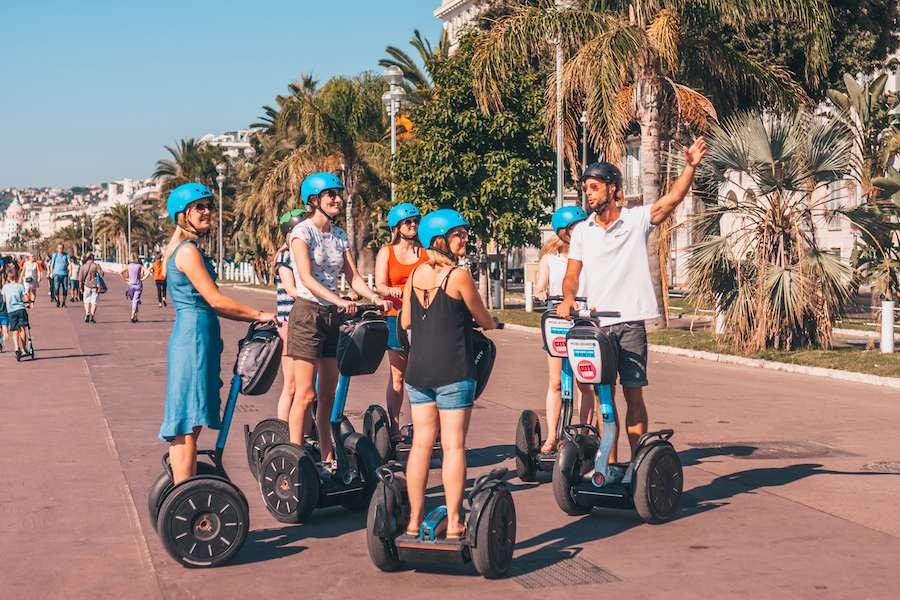
10 characteristics guests want in a tour guide
We’re all human and appreciate when people treat us with kindness and respect. So, when it comes to tactics for tour guide commentary, here are a handful of traits that guests look for in a tour guide:
1. A sense of humour
To deliver a compelling story, you may also have to be a funny tour guide . Sometimes, the world can throw curveballs and we all appreciate a reason to laugh.
You may find that funny, light-hearted stories will jive with almost any crowd. Keen to inject some humour into your script? Just ensure it’s relevant to your audience and relatable.
Remember to keep your audience in mind. Humour works best when it’s done sparingly. Jokes used for millennial backpackers might not work on retired cruise ship passengers.
2. Kindness
Pave the way for connecting with your guests by being kind enough to initiate conversation and listen to what they have to share.
Some travelers appreciate being asked what they’re hoping to get out of their experience and how far they’ve traveled to join in on your tour. Looking after small details and paying attention is a thoughtful trait that guests appreciate.
3. A guide who’s good with kids
Little ones have feelings and thoughts during their travels. After all, the whole world is new for them.
While it can be challenging to structure a tour for all ages, if you aim to be inclusive, you’re destined to win minds and hearts. Look into opportunities to highlight kid-specific topics and vantage points. Aim to schedule some pit stops along the route to keep everyone comfortable and happy.
4. Open-mindedness
Have you ever heard of the golden rule? It may seem silly, but by treating others how you would like to be treated, you help set the tone for how people in your group will interact.
Plus, when you get to know people personally, this helps to heighten their experience. After all, when guests book a tour they hope to be treated well. Help guests feel more comfortable and consider what different travelers might find interesting while on tour.
5. Informative storyteller
If you’ve been living in a region for some time, you probably have a wealth of knowledge to share. Guests expect that you’ll be well-informed and willing to share your local knowledge. Let’s say you’re looking at creative ways for how to train a tour guide , it’s key to bring your local knowledge and storytelling chops to the table.
6. Organized and punctual
Starting a tour on time is essential for every guest who made a point to be punctual and ready for things to start. Sure, mishaps happen and people find themselves in the wrong location. But as a general rule, you want to reward the guests who are prepared, by starting your tours on time.
Try sticking to time limits set for exploring an area and visiting different points of interest. In addition, guests hoping to make the most out of their trip will appreciate a tour that starts and ends right on time.
When guests book a tour, they put their faith in you to be direct and honest. Deliver on the promise and try to keep things on track with what your tour is supposed to include. Sometimes, it’s possible to get your facts wrong or not know the answer.
Ask if your guests have read up on the area and whether they have the answer. It’s not a bad idea to have a few key facts in your back pocket, so you do have the answers most of the time.
8. Adaptability
As a tour guide, you’ll potentially come across bad weather, detours or chaos from last minutechanges. Being adaptable is all a part of the role. This is where stories can keep your guests entertained if things go array.
The role of a tour guide is not without its challenges. You may have guests joining a tour with no minimal idea of what to expect, only having booked your tour because it was suggested to them. Keep things light and aim to be helpful for all travelers. This is where your uncanny ability to shift multiple hats is what makes you so good at your job.
9. Respectful
Sometimes, leading a tour may test your patience. You’ll find that respect can go pretty far, even if you don’t speak the same language. You may have to contend with late guests, irritated travelers and a wide array of personalities, but it doesn’t mean you can’t deliver an amazing tour for all.
Tour guests may not know or understand all of the expected cultural norms. Your role is to give travelers the benefit of the doubt, instead providing them with the opportunity to learn something new. And always keep your cool and remain respectful with tour guests.
10. Personality
Guests book tours with guides for a curated, hands-on and personalized experience. So, if they choose to book a tour with you, aim to dazzle them with your wealth of knowledge and personality.
Scan any negative online review and you’ll note descriptions like “cold, indifferent, boring or selfish” amongst the bad reviews. If travelers were looking for a generic experience, they could base a tour off a blog or seek out something on an audio walking tour. Make sure your personal touch is present throughout the tour.

Become a confident public speaker
If you find yourself getting nervous about speaking in front of a group of people, you’re not alone. We all worry about fumbling words or forgetting the material, but you know what’s awesome? Most people won’t know you’ve made a mistake unless you broadcast your error.
That’s part of the beauty in guiding. You can ad-lib, mix up the order and renege on your original script to make it perfect for your current tour group. Imagine guests reading reviews and coming to expect what you’re going to say next; now why would they bother booking a predictable tour?
Helpful things tips for your tour guide script:
- Focus on your guests : While it may be you doing the talking, your guests will be giving a lot of feedback with non-verbal cues. Aim to say just enough to keep them engaged and then move on.
- Forget the rules : focusing on them will only distract you. Make eye contact. Be animated with hands. Get to the point. Speak slowly. These will come naturally when you are more comfortable with public speaking. Take your time and enjoy th company of your guests.
- Invest in the story : Before the tour, pay close attention to your thoughts. Does the word can’t make a frequent appearance? If yes, it is time to change up your inner monologue. To be a better storyteller, you have to tell yourself you can . It seems like a cheesy exercise, but self-confidence makes a world of a difference.
- Create a set list : Have a few topics you know you’ll want to touch on throughout the tour to help remind you of your tour guide script.
- Take notes : You will get better with practice, but only if you learn from each attempt. Observe the audience’s reactions and write them down afterwards (not during — that would be strange). Next time, change your story up and repeat. Keep doing this until you know what details to emphasize more and what parts to leave out.
Use your tour guide script to be storyteller
As a tour guide you’re able to inform and entertain at the same time. Delivering facts while on tour doesn’t have to be a lecture. You can create a tour guide script that’s conversational and invites your guests into the experience.
Telling stories is a common way we communicate with each other. Over coffee with a friend, stories of weekend adventures are shared. At family dinners, your father brings up stories of your childhood. Even with the cashier, you may tell the story of why you forgot your reusable bags again.
You may find that you’re a natural when it comes to telling stories, and part of the reason could be that we’re hardwired to listen to them. Your past experiences, and the resulting stories, can contribute to the qualities of a good tour guide , helping you to create an incredible connection with your guests.
Whenever we listen to someone sharing a story, a large portion of our brain gets to work. Storytelling can engage three regions of the cortex : the motor, sensory and frontal. So why is storytelling important for tour guides? Want to figure out how to use storytelling to your advantage ?
In storytelling, try embracing the moment and not taking yourself too seriously. So throw a little of yourself in the content — even if the story isn’t about you. The narrator is part of the story as much as the characters are.

How to make good commentary in tour guiding
There are two types of stories to tell on tour:.
- Fun, wacky or exciting stories about a place. Told at the location of the site — either before or after listing relevant facts
- And personal stories. Best reserved for the in-transit, awkward moments of silence
For any location, there’s bound to be a large selection of stories to use on tour. But how do you choose the right ones?
It is best to base your selection around topics you care about — whether this happens to be architecture, food or history. Because when you are passionate about a topic, you will be more enthusiastic in your storytelling. And if you are excited to tell it, your listeners will be excited to hear it.
For your story collection, make a list of your own experiences. Some might be funny — even if they weren’t at the time. And some might be shocking — like you still can’t believe it happened to you. Out of all your stories, make sure they are appropriate and relate to the tour in some way.
Closing tour guide script
While you’re wrapping up the tour, you’ll want to close the experience for your guests.
Mention how you value guest feedback a few times throughout the tour. As an example of what to include in your tour commentary, make a point to share a point of interest that guests might not be able to find on their own.
Your closing tour guide commentary is also a great time to suggest other places travelers should consider, including restaurant recommendations and other tourist favourites.
And instead of telling guests that they should leave a 5-star review, which can seem disingenuous, encourage your visitors to highlight what makes this particular experience worth booking with an online review.

So, how can you become a better storyteller then?
Let’s go over important elements in crafting your story:
1. Hero/Protagonist
A story needs a character for the audience to cheer for. One they can relate to. Or one they will remember.
2. Objective
To create suspense, the main character needs a goal. The audience will listen in anticipation to find out whether the character succeeds.

3. Clear Incident
An obstacle must get in the character’s way. This makes it all the more interesting. Can they overcome it?
4. Harness emotion
You want the audience to feel what your characters are feeling. Empathy helps to connect the audience with your characters.
5. Add twists and turns
Unpredictable stories make the best ones. To keep the audience on their toes, throw unexpected twists and turns into the mix.
6. End with a punchline
Every story has a resolution, where typically the hero saves the day. No matter what type of story you share, aim to wrap up in a cheerful way — ending with a joke.
On your next tour, give storytelling a try. You might be surprised by your natural storytelling abilities and have a lot of fun while you’re at it.
Final thoughts
Right from the beginning, invite guests into the storytelling experience of your tour.
You don’t have to be the only one telling stories. Open up the floor and ask the audience questions. One story has a way of breathing other stories into life.
By giving your audience time to share, you might quickly come up with another. Also, the tour will have a more conversational tone, making everyone, including yourself, more relaxed. As a result, they’ll be more inclined to enjoy the tour and provide you with good, honest feedback.
Are you looking to hire a tour guide with these storytelling skills?

Get our list of 147 interview questions
Pick and choose from a range of questions to find the right guide for your tour company.standing support.
Related Articles

Unlock the power of feedback: how to ask your guests for reviews
“Checkfront has met our every business need, so far. Yes, we have had to reach out to Checkfront support for…
- Guest Experience

How to ask for TripAdvisor reviews
Seeking more online reviews? Learn how to ask for them in a way that gets results.
Search Blog
Subscribe to our newsletter.
Get tips and strategies to grow your business and impress your guests.
Blog Categories
- Booking Management
- Business Tips
- Marketing Strategies
- Operator Highlights
Effortless booking
Maximize online conversions with the most intuitive checkout online.
Expand revenue with our powerful Automated E-commerce tools.
Upgrade your website to industry’s best. Fresh websites. Fresh revenue.
Amplify visibility and expand earnings with integrated OTAs and local partners.
Streamline check-ins, limit risk, and amplify customer data with built-in digital waivers.
Transform data into insights. X-ray reporting gives you customer and business intelligence.
Manage high-volume walk-up customers effortlessly with POS, ticketing, and gated entry.
Automate management of staff schedules, assignments, and staff communications
Control your business precisely the way you want with endless yet easy configurability.
Allocate equipment used in various products. Prevent overbookings and maximize profits.
Grow with Xola in our constantly expanding universe of integrations and apps.
Harness customer data to drive marketing campaigns and generate repeat business.
Transform your guests into passionate brand advocates. Perfect your products & services.
Manage your business with the most powerful mobile suite in the industry.
Perfect the guest experience by giving your staff the industry’s most intuitive software.
Efficiently manage guest flow, minimize wait times, and ensure maximum satisfaction.
Ticketing & Entry
Revolutionize your guest experience: Effortless check-ins, interactive displays, secure payments.
Boost revenue with automated rave reviews, actionable insights, and loyal customer engagement.
Efficient ticketing, digital waivers, and fast check-ins enhance on-site operations and guest satisfaction.
Explore Xola Universe: 80+ apps, limitless integrations, endless growth opportunities.
Simplify check-in and boost your marketing efforts with our integrated automated digital waivers.
With SOC 2 Type II and CCPA compliance Xola exceeds industry security standards and insures your data protection.
Access real-time insights for business growth with our powerful reporting.
Remarkable and hassle-free guest experiences with waitlist and virtual queuing.
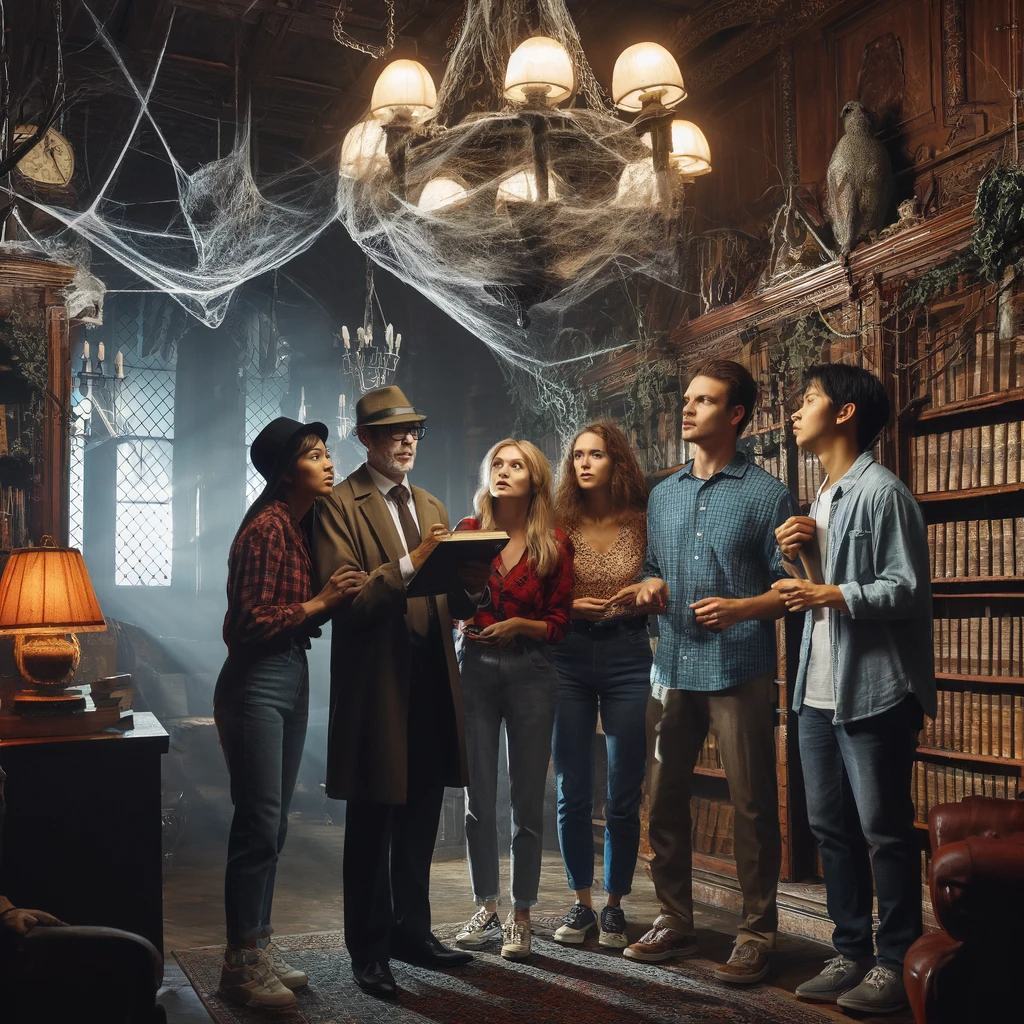
An overview of the best distribution channels
- Xola University
- Business Operations
How to write a tour script that your customers will rave about

There’s nothing worse than leading a tour to a group of bored guests. When your guests lose interest in the tour experience, it’s hard to grab their attention back.
This is why the most successful tours are based on a bulletproof tour scripts, a blueprint for the experience that’s been tested and revised over time.
In this guide, we’ll dive into the art of tour script along with sharing best practices and potential pitfalls to avoid.
What is a tour script?
A tour script is the backbone of a guided experience.
On paper, it’s a well-organized outline of the information, stories, facts, and interactions that a guide will deliver during a tour.
A tour script not only provides the structure for an experience, but also weaves a narrative that keeps guests engaged. It sort of serves as a guide’s compass, ensuring that they cover key points, interact with their audience, and maintain a consistent flow throughout the tour.
What are the benefits of writing a tour script?
Even the most experienced tour guides can benefit from a well-written tour script — here’s why:
- Provides structure and clarity: A tour script acts as a roadmap, ensuring that your tour follows a clear and logical structure. It helps tour guides organize their thoughts, preventing any confusion or stumbling during the tour.
- Keeps the experience consistent: With a script in hand, each tour becomes a uniform, high-quality presentation of information and anecdotes.
- Engages your audience: A well-written script captivates an audience with engaging stories, facts, and insights.
- Gives your guide a chance to introduce themselves: A script should feature a fun introduction, allowing guests to build a personal connection with your guides right away.
- A confidence boost for guides: Armed with a ready-to-go script, tour guides feel more confident and prepared — which, in turn, translates into a more enjoyable delivery.
5 steps for writing a tour script
Let’s take a look at how you might create a compelling tour script that leaves a lasting impression on your guests.
Step 1: Define your tour’s theme and goals
Begin by clarifying the central theme and objectives of your tour. Are you highlighting historical sites, local cuisine, or natural landmarks?
Then, define your goals. Are you educating, entertaining, or both?
Let’s say you live in Philadelphia: The city has heavy historical significance, so you design a walking tour that takes guests on a chronological journey of the signing of the Declaration of Independence.
With your tour’s theme and goal in mind — “historical” and “to inform” in the example above — you can start to create a cohesive and memorable storyline.
Step 2: Research your content thoroughly
Gather detailed information about the sites, facts, and anecdotes you plan to include in your script. Double- and triple-check your facts with reputable sources, historical records, and local experts.
While you’re researching, take special note of interesting tidbits and any quirky stories that come up. These can be used as “fun facts” throughout the tour.
The more knowledgeable you are, the more engaging your narrative will be. Your research will give your tour credibility and provide you with the proper ammunition to answer guests’ questions.
Step 3: Write a captivating introduction
An engaging opening sets the tone and captures your guests’ interest from the start.
With that in mind, write an attention-grabbing introduction for each segment of your tour.
For example, at the city’s oldest building, you might start with, “Welcome to the cornerstone of our journey, the Old Town Hall. Let’s unlock its secrets together.”
This will hook your guests’ attention and keep them interested in each stop of the tour.
Step 4: Make the script interactive
Include interactive elements that encourage guest participation, like thought-provoking questions, fun facts, or challenges.
For example, when visiting a site that used to be a market, pose the following questions to your guests: “Can you imagine the bustling market that once surrounded this square? What do you think was the most popular item sold here?”
When guests actively participate in the storytelling, the experience becomes more memorable for them.
Step 5: End with a memorable conclusion
Craft a conclusion that ties together the main themes and emotions of the tour.
Let’s say your tour ends at the city square. You might say something like, “Our journey has unveiled the stories etched in these stones. As you leave, remember the resilience and spirit that continue to shape this city.”
A strong conclusion leaves guests with a sense of fulfillment and a positive impression of the tour, increasing their likelihood of sharing positive feedback.
Don’t forget to remind your guests to leace you a review on your preferred OTA platform and/or website. Including this quick call to action will motivate guests to provide you feedback once they leave your tour.
How to write a tour script for an in-person live tour
When writing a tour script for an in-person live tour, you need to consider all the factors that can make or break a face-to-face interaction.
The more your interact with your guests — like prompting them with trivia questions and sharing anecdotes — the more engaging the tour will be.
In a live tour, you can also use body language and facial expressions to enhance the storytelling experience. Think through how your gestures can complement key points, and where to establish eye contact to connect with different audience members.
Finally, pay close attention to your audience’s reactions. Adjust the pacing and delivery of your speech based on their engagement level. Make sure to leave room for spontaneous interactions and allow time for guests to ask questions.
How to write a tour script for a self-guided audio tour
Unlike live tours, where guides lead in real-time, audio tours rely solely on your script to captivate visitors.
Begin with clear and concise descriptions of each point of interest. Since you won’t be there to address questions, the script should be comprehensive and help listeners visualize their surroundings. Use navigation cues so they can progress from one point to another. Mention landmarks, specific directions, and a logical sequence to guide them.
Storytelling is just as important in a self-guided audio tour — if not more. Your script is the only thing that will keep visitors engaged; fill it with anecdotes and background information about each point of interest.
Finally, timing is key to preventing listener fatigue. Leave ample room for reflection between each audio segment.
How to write a tour script for a virtual tour
Virtual tours, like audio tours, rely solely on your script to take participants on a journey from the comfort of their screens.
Here, you’re not limited by physical constraints, so you can create a fluid narrative that transitions smoothly. Your script will guide viewers through different locations, so make sure to describe the surroundings in detail to enhance the visual component of the tour.
Again, storytelling remains essential. Your narration should foster a sense of exploration — the better the narration, the more immersed the viewer will feel.
Similar to an in-person tour, interactive prompts should also be used to keep viewers engaged throughout.
3 examples of great tour scripts
Here we’ll dissect three great tour scripts — from a cathedral in Dublin, a safari in Toronto, and a museum in Milwaukee.
We will start from here (presuming you are standing near Celtic Gravestone at shop); walk down into the north transept, or left arm, of the Cathedral. We will stop again at the Choir and then loop around into the south transept finally ending up back roughly where we started. The tour will last approximately 40 minutes and if you have any questions as we go please don’t hesitate to ask.
Then, the script begins by sharing the story of St Patrick himself.
“You may not be familiar with the story of our patron saint,” it says, ensuring that everyone in the group is on the same page. Rather than just pointing to the pictures on a window of the cathedral, the script tells the saint’s story through those pictures. The ongoing narrative captures the audience’s attention and keeps them engaged throughout the tour.
This script also includes several “optional extras,” such as an organ containing over four thousand pipes. This is a great way to give the guide some flexibility. Tour guides have the ability to read a crowd — they can then make extra stops that align with the interests of each group.
Self-guided tour
Toronto Zoo’s Scenic Safari drive-thru tour is a self-guided adventure.
The audio script starts with a message from the CEO warmly welcoming visitors to the zoo. It’s followed by important safety rules that remind visitors to remain in their vehicles, keep noise to a minimum, and drive no faster than 5 km per hour. It’s important to start a self-guided tour with any guidelines that apply to the visit since there is no physical guide present.
The zoo points out interesting facts to pique visitors’ curiosity throughout the tour, like “Did you know that a tiger can bite down with the force of 1,000 pounds” and “A ‘long call’ from an orangutan can be heard up to 2 kilometers away.”
It also uses trivia questions to keep them engaged: “What color do you think a yak’s milk is?”
Mixing educational elements with storytelling makes the safari tour even more memorable for visitors.
Virtual tour
The Milwaukee Public Museum offers 360° virtual tours , including one of a gallery focused on the common traits shared by all civilizations.
The virtual tour starts at the entrance and moves through an interactive screen that showcases each section of the Crossroads of Civilization exhibit. The script has clear navigational cues, like “You are standing before a model of the First Courtyard of that temple while it is under construction.” This gives the visitor a sense of direction within the virtual experience.
The script also keeps users engaged by offering additional features only available online — like a PDF about colors used in ancient Egyptian art. Viewers can then choose to delve into the topics they’re most interested in, making the tour feel more personalized.
6 best practices for writing an engaging tour script
Breathe life into your tour script with these key strategies:
1. Use humor
Infusing humor into your script can transform a mundane description into a memorable anecdote. Don’t be afraid to let your personality shine — and don’t hold back on witty stories or lighthearted observations that make your visitors laugh
For example, during a historical walking tour, you might playfully mention how a renowned figure’s statue seems to have witnessed centuries of gossip.
2. Tell stories
A well-told narrative can transport visitors into the past or alternate realities. Being a good storyteller is key to captivating your audience’s imagination. While guiding a tour through an art gallery, you could share the fascinating backstory behind a masterpiece, revealing the artist’s personal struggles and triumphs.
3. Use clear and simple language
Make your script easy to understand. Avoid jargon or technical language that non-experts on the subject wouldn’t understand. Imagine leading a wine-tasting tour: Instead of delving into technical terminology, you would describe the flavors and aromas in relatable terms like “notes of ripe berries” or “subtle hints of oak.”
4. Incorporate interactive elements
Engagement flourishes when your guests are actively involved. Questions, prompts, or challenges encourage them to interact with their surroundings, keeping the group interested from start to finish. For instance, while guiding a hiking trip, you could prompt hikers to look for specific bird species and share their discoveries with the group.
5. Create emotional connections
Always start your tour script by introducing yourself in a friendly manner. Then, make your passion for the said activity known. When guests see how excited you are about the tour, this excitement will translate back to them. During a walking tour, for example, you might share your history with the city, including your favorite memories there.
6. Embrace surprise and curiosity
Unexpected twists or intriguing facts spark curiosity and attract your guests’ attention. On that same walking tour, for example, you might reveal a hidden alleyway with a captivating history, leaving them eager to explore further.
3 common mistakes in tour script writing
There are a few common pitfalls that can dampen a tour script’s impact. Here are three mistakes to avoid:
1. Information overload
One of the most common mistakes is overwhelming participants with too many details. Bombarding them with an abundance of historical facts, dates, and figures can lead to information fatigue.
Instead, focus on delivering key highlights that are relevant to your narrative. For instance, on an architecture tour, avoid inundating participants with every structural detail and instead focus on the stories behind the most interesting buildings.
2. No interaction
Tour scripts that merely deliver a monologue can fall flat. Neglecting interactive elements can leave participants feeling disconnected from the experience.
To avoid this, leave room for your guests to ask questions, share their observations, or even participate in mini-activities.
During a food tour, for instance, you might ask guests to talk about their favorite meal, fostering a sense of participation.
3. Ignoring pace and timing
You can quickly lose a crowd by rushing through explanations or dwelling excessively on minor details. Dragging out a segment can also bored your guests to death.
Tour guides need to strike a balance between information overload and conciseness. They can do so by allocating appropriate time for each stop and topic. For example, on a museum tour, you’ll allot extra time to explore a major exhibit, ensuring that visitors have ample time to absorb the information.
A well-written tour script possesses the power to immerse guests in your experience. By marrying your storytelling techniques with thoughtful interactions and original humor, your scripts will result in tours that leave a lasting impression on your guests.
Writer Carla Vianna
Related Articles
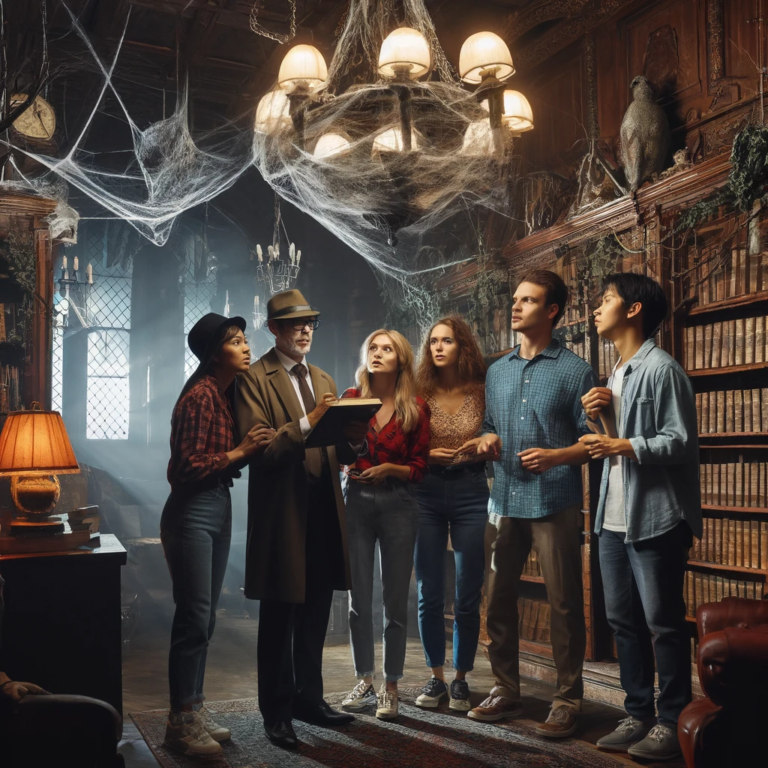
You’ve likely considered the pros and cons of listing your tours with a third-party website. While your own tour website

6 examples of how tour operators can use AI to automate tasks
We know there’s a lot of buzz around Artificial Intelligence (AI), and you may not think there’s anything in it

How to find the best tour booking software for your company
Thousands of businesses rely on a comprehensive booking management tool to streamline operations and enhance customer experience every day. With
Get the latest news and resources.
For tours and attractions delivered straight to your inbox each week.
Transform your business now.

How to write exciting tour guide commentary

By Rezdy — 21 Feb 2016
tour guides
Updated September 2022 – You don’t want to be the tour guide that everyone dreads. The one that drones on and on about facts, figures and historical destinations that people will see along the way. We’ve all been on one of those tours before, trying to surreptitiously check our watches to count down the minutes until it’s over.
As a tour and activity provider, you want your tours to be fun, exciting, funny, and memorable. You want to be the guide that captivates a group of travelers from the first moment they step aboard the bus, and keep their attention until they are climbing out after a fun day of sightseeing. But writing your tour guide commentary can be a difficult task when you’re unsure what your customers are looking for when they sign up for your tour.
These tips will help you understand how to write a tour guide speech that ensures your customers will have a fun and memorable time.
Why is engaging commentary important for tour guides?
Knowing how to make a commentary in tour guiding that’s interesting and engaging is one of the key qualities of a good tour guide . Vivid storytelling and accurate historical accounts will improve the customer experience, and ultimately earn you a reputation for being a premier tour guide in the region. This will help increase your bookings and allow you to continue to grow your business through positive and genuine online reviews that actively drive more potential customers to your website.
What guests want out of tour guide commentary
Whether you’re wandering through the ruins of an ancient city or meandering through an art gallery while creating a live virtual tour , some things stay the same when it comes to what guests want out of tour guide commentary.
Here’s what you should keep in mind if you’re wondering how to write a tour script that captures everyone’s attention:
A sense of wonder

Make your travelers curious. Start the tour with questions and statements that evoke their interest and curiosity, such as “Have you ever wondered what it might be like to live in a beautiful castle on the coast of the sea? Well we are about to go to a building where there was drama, romance, crime, and passion.” Get them excited about where they are about to go, and let their imaginations run wild along the way.
An emotional rollercoaster
Instead of reciting facts and figures about certain buildings, tell them about the people who worked there. Use your tour commentary to explain the tragedies that happened in your little corner of the world. Allow your guests to feel anxious, excited, happy, sad, and nervous — right along with the characters that you are describing in your historical accounts.
Unexpected twists and turns
Shock them with a story they don’t expect. When you are visiting a famous monument in the city, people expect to hear about the creators, the history behind the construction and the specifications about the building itself. While these are important figures and you might want to incorporate them into your guide, you should also surprise your guests by telling a more personal story about the monument. A funny memory of a previous tour could get people laughing, or you could tell a little-known story about the history of the monument.
Tasteful humor

Whether it’s responding to customer comments with witty quips or inserting strange but amusing facts into your commentary, humor can transform an average tour into a memorable and fun experience. Laughing makes everyone feel good – including your customers. Sprinkling in a dose of good-natured humor is a fantastic way to engage people and ensure that your customers leave the experience feeling not only satisfied, but also singing your praises.
Historical facts
One of the main reasons people go on tours is to learn interesting facts that they wouldn’t be able to hear otherwise. Historical facts don’t always need to be framed by a long-winded story. Pointing out interesting details on your tour with a short, snappy historical fact is a great way to add flavor to the entire experience. The amount of historical information that you pepper into your tour commentary will ultimately wind down to your location and the type of tour itself. But even if you aren’t offering an official historical tour, the occasional fact can do wonders for engaging your audience.
Your own personality
Add your own personality to your tours. This is the most important aspect of storytelling. Be yourself, and let your own personality shine through. If you’re a little quirky, let that weirdness show. If you love to make people laugh, then tell jokes the entire way. Your personality is going to make or break the guided tour, so enjoy yourself while doing your job. A summary of effective tour guide commentary: from start to finish Need inspiration for transforming your first rough draft into a polished tour guide commentary script? Here is a walk-through of how to write a tour script that does your location justice.
Establish a “hero” to root for

People are drawn to stories about relatable characters. Creating or drawing on historical inspiration to craft a ‘hero’ character can allow you to trigger positive emotional reactions in your audience and contextualize the facts that you are sharing in your tour commentary.
Tie your stories to a theme
Disjointed stories about completely different topics can confuse audiences. When you’re writing your tour guide commentary, imagine you’re creating a collection of short stories connected by an overarching theme.
Focus on short and simple stories
It’s tricky to keep your attention focused on a long, complicated story when you’re submerged in a new environment that is brimming with exciting attractions and activities. Short and simple stories are more engaging and effective than lengthy narratives. Don’t ignore the power of a snappy and impactful story when writing your tour guide commentary.
Finish with a feel-good ending
Time to tie the experience together in a neat package wrapped up with a nice bow. A feel-good ending will ensure that everyone walks away from the tour with a solid understanding of what they learned and experienced.
Revise your script

No great story was ever finalized without several rounds of editing. Ask your friends, family, and coworkers to read your commentary and provide feedback.
A comparison is also a handy tool that provides you with greater insights into areas that need improving. Consider writing multiple versions of your script and then comparing them to identify strengths to focus on and weaknesses to eliminate.
As your business grows, you might want to consider implementing an online booking system. By ensuring your online booking system creates an easy booking process, you’ll be setting positive expectations of customer satisfaction before the tour or activity even begins. With an online booking software in place, your customers will be able to self-book at their own pace in an efficient and secure manner.
For instance, Rezdy is an automated tour booking software and tour Channel Manager that is designed specifically for tour and activity providers. Rezdy’s booking software equips your business with advanced features such as real-time availability viewer, avoiding the possibility of over/double bookings, automatic communication to keep your customers updated in the loop of any updates and reminders, and secure payment gateways that allows your customers to make secure online payments on the spot.
On the other hand, Rezdy Channel Manager also amplifies your booking levels by connecting you with thousands of agents and resellers worldwide. By using a tour operator marketplace, you’ll be able to expand your reach and broaden your distribution channels to thousands of potential customers from around the world.
You can experience everything that Rezdy has to offer firsthand by starting your FREE 21-day trial or booking a demo with our team of experts to help you understand how Rezdy can fit within your business.
If you enjoyed this article, make sure to subscribe to our newsletter , where you’ll receive up-to-date resources; from marketing tips, business operation advice, and even the latest industry news.
Start getting more bookings
Enjoy 21 days to take a look around and see if we are a good fit for your business.
No obligations, no catches, no limits, nada
Business Operations

How to create a Google Business Profile for tour operators
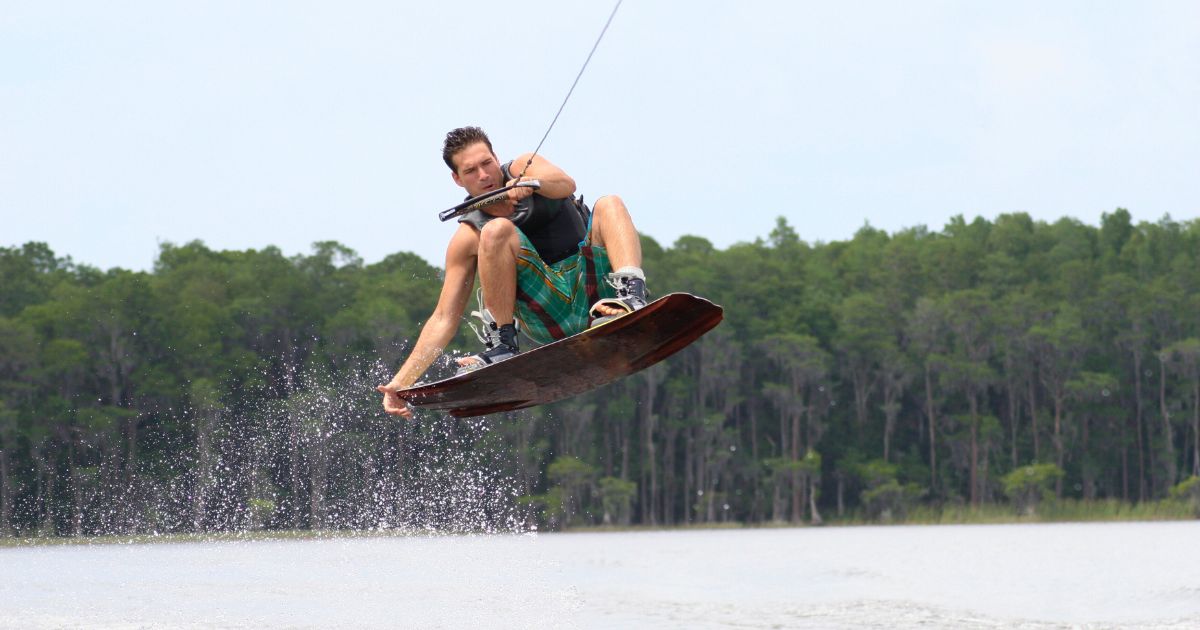
How to set up an online booking system for tour businesses

7 tips to fostering diversity & inclusion in your tour and activity business
How to write the script for my tour?
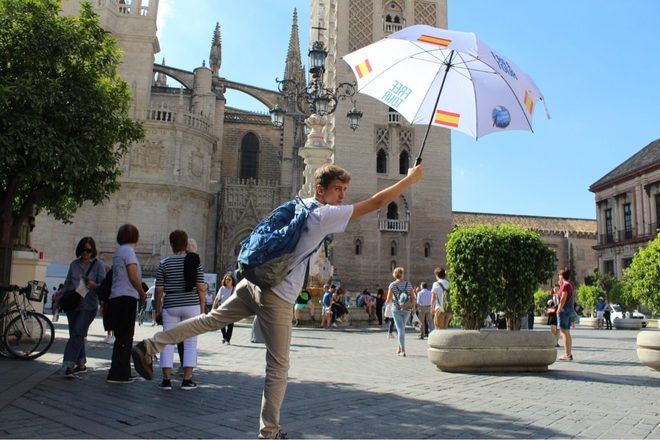
A free walking tour is like a play: each word is of vital importance to transmit your speech in the best way and touch the emotions of your travelers. In this post, we will explain how to create an amazing script, which will be the bible of your journey. It will allow you to choose the best content in order to create an incredible experience and receive lots of money.
Before creating the tour script
Before starting to write the script, you should be aware of at least these 2 elements:
- Make sure to have identified all the places of interest (ex: town hall) and topics (ex: gastronomy) that you want to introduce throughout the tour.
- Make sure to have ordered all the places and topics to create your tour itinerary , taking into account a coherent structure and the shortest distance between each stop (max. 2-3 minutes).
If you have any questions about that, we strongly advise you to read this post first to define the itinerary of your tour.
1. Create a great introduction
Think about it as if it were the first few minutes of a movie or the first pages of a book. You have to create the “WOW” effect.

Your tour introduction has several goals:
- Captivate your travelers: you have to show travelers how special this experience will be with you and that it was worth booking. Make it clear that you will exceed the expectations they have.
- Break the ice: travelers don’t know you yet, they don’t know your city, or the other travelers in the group. It’s important to reduce this tension from the beginning.
- Give confidence: You must show your professionalism and credibility so that travelers can trust what you explain.
This introduction is usually short (5 minutes) and is normally structured like this:
- Say hello, welcome them , thank them for booking with you, introduce the tour and get the travelers’ interest.
- Introduce yourself to the group (and sometimes the travelers among them): here you have to show your credibility (experience, studies, time spent in the city …) so that the travelers know that they made the best decision booking your experience.
- Tour structure (key sights) and practical information (duration, if there will be a break to go to the bathroom, the payment concept, …). You make sure travelers know what to expect from you and to show them your professionalism.
- Get travelers’ interest and give time for some practical questions.
Then, in the same place, gurus usually start with their first explanations (most of the time, it’s an historical introduction of the city and the country). This explanation is normally a bit longer than the others (10-15 minutes) and serves to put the context for the rest of the tour. It’s also important to start at the meeting point so late travelers can still join.
2. Balance the types of content

It’s important to find a balance between the different kinds of content to include in your tour so it’s easy for them to follow you.
These are the different types of content that your tour must include:
- History: it’s usually the main focus for the content of your tour and helps to introduce the rest of your explanations. In many cases, travelers have already read part of the story before joining the tour in their travel guide or online but it’s important to explain it as travelers expect it and to put everything in context. It can be both the history of a building or monument, as well as the history related to a topic (specific period, important social movement, gastronomy, …).
- Anecdotes and curious legends: that’s what makes the difference for travelers and what they will remember, since it’s usually something that surprises them and that they don’t usually know about. It touches travelers’ emotions and keeps their attention. This kind of content is usually explained after the historical context.
- Customs and recommendations: Travelers who participate in a free walking tour don’t just want to listen to stories. They also want to be able to understand the city as a local, live as a local and go to places that are not as touristy. That’s why it’s important to include some local customs and personal recommendations in your tour.
You can balance the content both from one spot to another and within the same explanation of the place! (Ex: have a moment to talk just about recommendations or include recommendations after an historical overview).
3. Find the content and write the tour script
Now that you know the type of content you need, it’s time to search for it.
There is no miracle , you will have to read a lot, watch many documentaries, visit many places, talk to the tourist office, experts … and that takes a while.

While doing this research, also consider the following things:
- Keep only the most essential and relevant information: you can talk for hours about some places, so it’s important to select only the most interesting part for the traveler.
- Open your search beyond the content of the tour: If you read more than the content of your tour, you’ll be able to show to travelers that you are a true professional by answering all their doubts, which often go beyond what you explain on the tour.
- Verify the data: you can’t trust just one single source of information. Cross-check the data to ensure your script’s content is reliable.
- Write in an understandable way for everyone: sometimes travelers don’t know anything about the topics you are dealing with on your tour, so you have to explain it in a simple and clear way and avoid technical words.
- Think of practical information: free walking tours give travelers a general overview of what the city can offer, so they can then visit some places on their own. That’s why it’s important to know the practical information of the most important places in your city and to include them in your tour: opening hours, ticket prices, how to get there, …
4. Think of the best way to explain your stop
Just as you did by selecting the type of content for your tour, you must also balance the different ways of transmitting this content, which will create a much more enjoyable experience.
Maybe you can explain a personal story, or perform a historical event with travelers, even teach them how to prepare a traditional recipe, or make a quiz … You can find more information on this topic by consulting this post on how to create a more interactive tour and in this post on how to create amazing explanations .
In addition, you can include your travelers better by asking them questions , as we explain in more detail here .
5. Create natural transitions in your itinerary

Maintaining the logic between your explanations can be achieved when you have good transitions, because it gives a common thread to the whole tour. Your experience is not just going from one place to another, you have to see it as a set where each explanation tells a story that supports the overall idea of your experience, like a movie with different scenes.
Good transitions allow travelers to better remember key facts and will help make the journey more meaningful. It also helps you memorize your speech better and will keep travelers interested to follow the whole tour.
You have to add these transitions at the end of the stop or when starting the next one. It can also serve to get travelers’ attention and surprise them, as we explain in this post .
6. End the tour with style

The final part of the tour has to be the cherry on top. Like a good movie, the final part is essential and will be the last impression travelers get before paying you. It’s important to make an emotional ending , so travelers realize how awesome this experience has been with you.
Many gurus achieve this by choosing a very special place to end their tour, such as a vantage point with a spectacular view of the city. Others choose a site that is relevant to the common thread of their tour, because of the history of that place.
What is usually said at the end:
- Summarize the most important elements of the tour , show travelers that the experience was amazing and that they have learned a lot with you.
- Give options on things to do after the tour.
- Remember that they will receive an automatic email from GuruWalk to leave a review on your profile and explain why it’s so important they do so (it allows you to get more bookings).
- Thank them and wish them a good stay.
If they give you an applause, it means that the tour and its ending have been a success.
7. Control time, practice and improve the tour script

Remember, the best free walking tours last between 2 and 3 hours. Shorter than that, travelers will feel that the experience was not complete and longer, you will tire them out too much and they will end up bored.
With Google Maps, you can approximate the time you will need to walk. In this example of an itinerary in Brussels, which is a 2-hour tour, you walk about 40 minutes, leaving 1h20 to tell stories. Only the main stops are represented there, but there are about 10 stops, which makes 10 minutes per stop, taking into account that the first stop is usually longer, so it’s fine.

So, you can put a timer so that each stop on your script is no more than 10 minutes. It is not an absolute rule. There are places that require more time and others less.
Now that you’ve added or removed content from the tour script, it’s time to practice it at home and learn it well.
Once you have it ready, practice it with a friend or family member in real conditions. This person can also give you valuable feedback to improve your speech. Look at the time before starting the tour and halfway through the tour, verify your progress at the halfway point to make sure you are on target. If not, you will have to add or remove content.
You have to constantly review your tour script . With practice, you will realize what is more or less interesting to travelers.
However, keep in mind that the speed of the group is always different. So you have to identify less important explanations or places that you could skip or add to meet the duration of the tour.
It’s important to memorize the tour script perfectly. In front of the group of travelers, you can’t doubt or read something from a notebook. Otherwise, you may lose all your credibility (and money… ).
What’s next?
Do you have your tour script ready and are you learning it? Before doing your first tours with travelers, check out this post about the most common mistakes when starting as a tour guide and how to avoid them.
Your email address will not be published. Required fields are marked *
How to Write a Tour Guide Script?

Table of Contents
Every trip needs a plan for the tour guide. Your visitors come to you excited and curious to see a new place, learn something new, and have a good time.
You are the one who lives up to their hopes. So, carefully preparing the script ahead of time with good communication and stories will help you feel confident when speaking in front of your customers and give them a good time.
There are many things you need to do to write good tour guide stories that will impress your customers. But don’t worry, this guide will help you out how to write a tour guide script?. Why don’t we learn together?
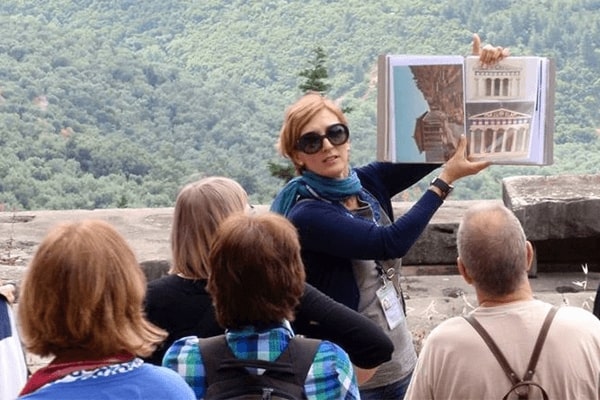
Researching the Destination
Key points of interest and unique features.

In the first step, you need to figure out what the most interesting and unique things are about the place you want to write a tour guide story for.
This will make it easy for you to fill out the rest of your script in the next step and make sure you don’t miss any important parts of the destination.
If you want to give customers full, high-quality information about a location, you have to know a lot about it. This takes a lot of online and offline research. Here are some things you need to work on, according to us:
- Read materials from the official tourism websites of the country or the province: They provide quite complete and trustworthy information about the destination.
- Read more research, publications and books related: These sources are great to get more valuable details about the destination.
- Read content from other travel agencies blogs
- Conduct a field trip to that place
- Join other tours to learn from their tour guide scripts
When you read information from unofficial sources, you might find different pieces of information that don’t match up. If you want to use this information in your script, make sure to check it twice. Make sure that all the information you give your customers is right.
In addition to learning about the location, you should always learn more about other things. So that if a customer ever asks you a question, you can always answer it with confidence.
This shows your clients that you are a real expert.
Understanding the Target Audience
Who is the target audience for the tour.
After doing study on the destination, the next step is to figure out who you want to reach.
This step is important, but a lot of people skip it. When you know who you’re writing for, you can make sure the story is right for them. Because each customer group has different needs and wants.
Here are the most basic things you need to know to figure out who they are:
- What is their age group?
- Their occupation?
- Their level of education?
- Where are they from?
Once you have identified the target audience for your tour, continue with the following questions to understand them:
- What are their needs, preferences, and goals?
- How do they communicate and consume information?
- What are their cultural norms and values?
After having a full understanding of your customers, you can estimate how receptive they would be to different parts of your tour guide script. You can foresee what emotions may trigger, offend and how to better deliver the information and communicate with them.
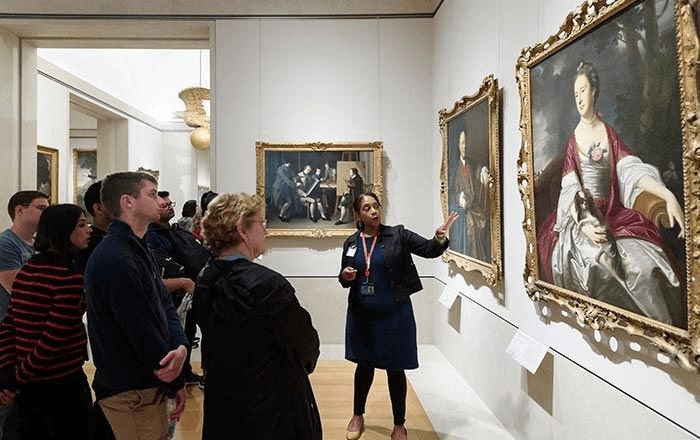
Using language and tone appropriate for the audience
Next, let’s define the language and tone to use for your tour guide script. Keep in mind that how you are saying is as important as what you are saying. So, depending on who your target audience is, use language and tone that suits them.
1. Children : Use simple language, avoid advanced words and technical terms. Use a cheerful tone to create closeness and friendliness.
For example: “Today, we are going to talk about some animals that existed a long long time ago – 65 million years ago! Does anyone know the name of this animal? Show me your hand! I’m sure you have heard about dinosaurs and have seen them in many cartoons…”
2. Young adults : With young people, you can use advanced words to convey the ideas better. Be comfortable to use slang, trendy expressions and jokes with a humorous tone because they would love that.
For example: “Do you know how long dinosaurs lived? The same as short ones! Just kidding. Dinosaur lifespan has been debated for many years….”
3. Seniors : With seniors, you should avoid using the language of the young generation. Use more formal language, and being respectful is extremely important.
4. Foreign visitors : When explaining to foreign visitors the history or culture of your country, you should speak slowly, and be patient with them when talking about things they may find unfamiliar with.
Okay this is important: You should avoid using slang, or expressions that might be confusing, offensive, or inappropriate for your audience.
In addition, depending on the topic you talk about, you also have to adjust the language and tone accordingly.
For example: When you’re talking about history or wars, use formal language and a heroic tone. If you’re talking about entertaining topics, use casual language and a cheerful tone.
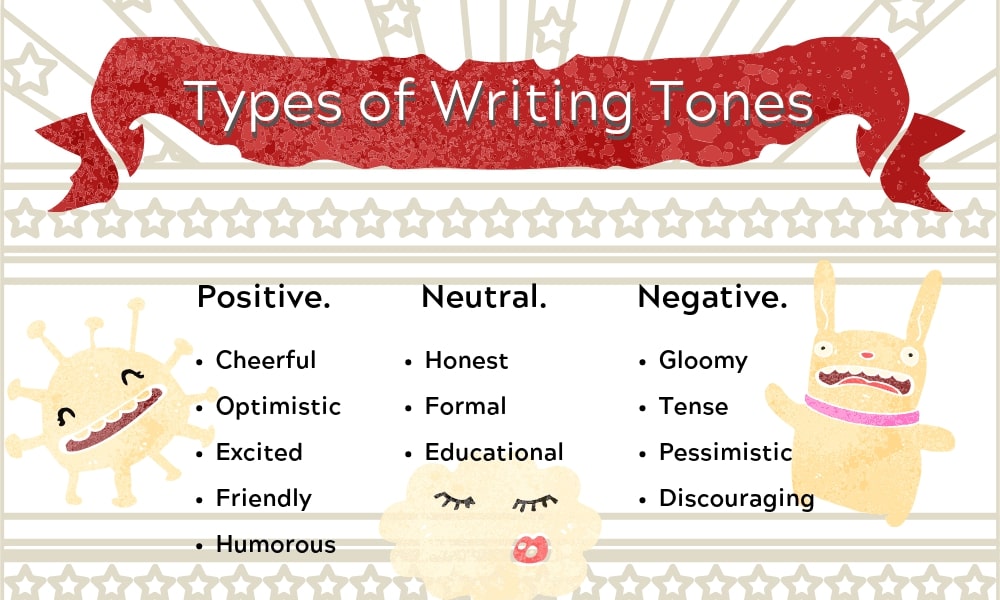
Incorporating humor, anecdotes, and interactive elements
Trying to keep people’s attention for a long time is not easy. You can picture tourists yawning, being distracted, or doing their own thing while the tour guide talks with emotion. This kind of thing happens all the time in real life.
Don’t worry, you can make things better by adding humor, stories, and interactive parts. If your tour guide script is just a list of facts and doesn’t have any of these things, your clients will soon get bored and tired of it.
People will also be able to remember the important details and information better, and they will feel more connected to the location, which will make the trip a memorable one for them.

Humor can lighten the mood immediately. The audience is more likely to remember you if you make them laugh and in turn remember your ideas and key points. You can show your sense of humor throughout the whole tour.
For example: “I’d like to take some time to inform you about brief safety
precautions. Always remember to S-M-I-L-E. Can I see your beautiful smiles? Very good. So SM-I-L-E for S, secure your personal belongings…”
Stories keep tourists curious about what you are going to tell. As a result, it is a tool to grab everyone’s attention and keep them focused. Tell stories whenever possible. If you can convey information by storytelling instead of other forms, do it.
Tips for great stories for your tour guide:
- Have a clear message or information for your story that you want to tell your tourists
- Show them, don’t tell them
- Create tension in your story and resolve it
The don’ts:
- Don’t overwhelm your story with unnecessary details
- Don’t make it too long
Beside humor, and stories, there are other interactive elements that you can incorporate in your tour guiding.
3. Other interactive elements:
- Ask the audience
- Try out a quiz
- Make eye contact
- Body language
Not everyone was born with a natural sense of humor or mastered the art of storytelling. But the good news is that you can learn and practice to be good at it.
Here are some tips to help you improve:
a. Join tours and learn from great tour guides b. Listen to good talks on any topic c. Observe people around you in real life and on the internet
If you really pay attention and observe, you can learn a lot from your everyday life. Whenever you come across a good joke or an interesting expression, memorize it and write it down in a notebook. So that you can use them in your tour guide script later!
Structuring the Script
Now you are ready to start writing. The next step is to plan out how the tour guide story will be put together. Before you write the details, your presentation will be more convincing and professional if it has a clear and logical format.
A tour guide scripts is usually made up of 5 main parts:
- Introduce yourself to the group: You have to show your credibility such as your working experience, studies, time you have spent in the city, so that the travelers can have trust in you, and believe that they have made the right decision to book the tour with you.
- Regulations and reminders during visiting the destination
- Outline the tour content: Sections and the main ideas of each one. Let customers know what to expect from you and give them a sense of direction throughout the journey.
- Detailed content of each section
- Closing: Summarize all of the main points of the tour
You already knew about the destination’s main places of interest based on what you learned and found in step 1. Now, decide how you should put these points together so that they make sense.
In places like museums, the aisles and material are set up in a way that encourages people to look around. Then you just need to make an outline of the text based on that.
As for other tourist spots that aren’t like that, like historical sites or beautiful places, you’ll have to figure out the plan. There are different ways to put your information in order:
- Chronological sequence
- Spatial order
- The order of things
- Topical order
Craft captivating tour guide scripts effortlessly with our tour guide script tips. Seamlessly integrated with TravelerWp , our WordPress theme with a powerful booking engine . Elevate your tour guiding today!
Writing Techniques
After you have a clear and sensible structure, you will write the tour guide scripts’ content details. As you know, there are many ways to write, and each one is good for something different. But for a tour script, we strongly suggest that you use detailed language and language that appeals to the senses.
Using descriptive language and vivid imagery
Words used to describe things or acts are called descriptive language. They also include rhetorical arts like comparison, imagery, and metaphor.
When you read words that describe things, you get a clear picture in your mind. When describing a real tourist location, using descriptive language will help people see and feel the beauty of that place more deeply. On the other hand, if you use descriptive words in your stories, your readers will feel like they are right there with you.
You should also use sensory language in your tour guide writing, along with descriptive language. The sensory language uses all five senses to make your customers’ experience better. By using sound, sight, smell, touch, and taste, you can make your audience’s imaginations come alive.
Example: “Let me take you to 65 million years ago… The dinosaurs are playing and talking joyfully to each other at a waterfall (PERSONIFICATION & DESCRIBE ACTION). The waterfall is aquarium-blue (DESCRIBE COLOR). It is pounding the rocks and tumbling down the mountain (DESCRIBE LOUD SOUND). The bliss-pool at the bottom was varnish clear (CREATIVE). It looked like a wall of blue satin threaded with silver (DESCRIBE TEXTURE). The flowers next to it were nodding gently, casting a honey sweet smell (DESCRIBE SMELL).”
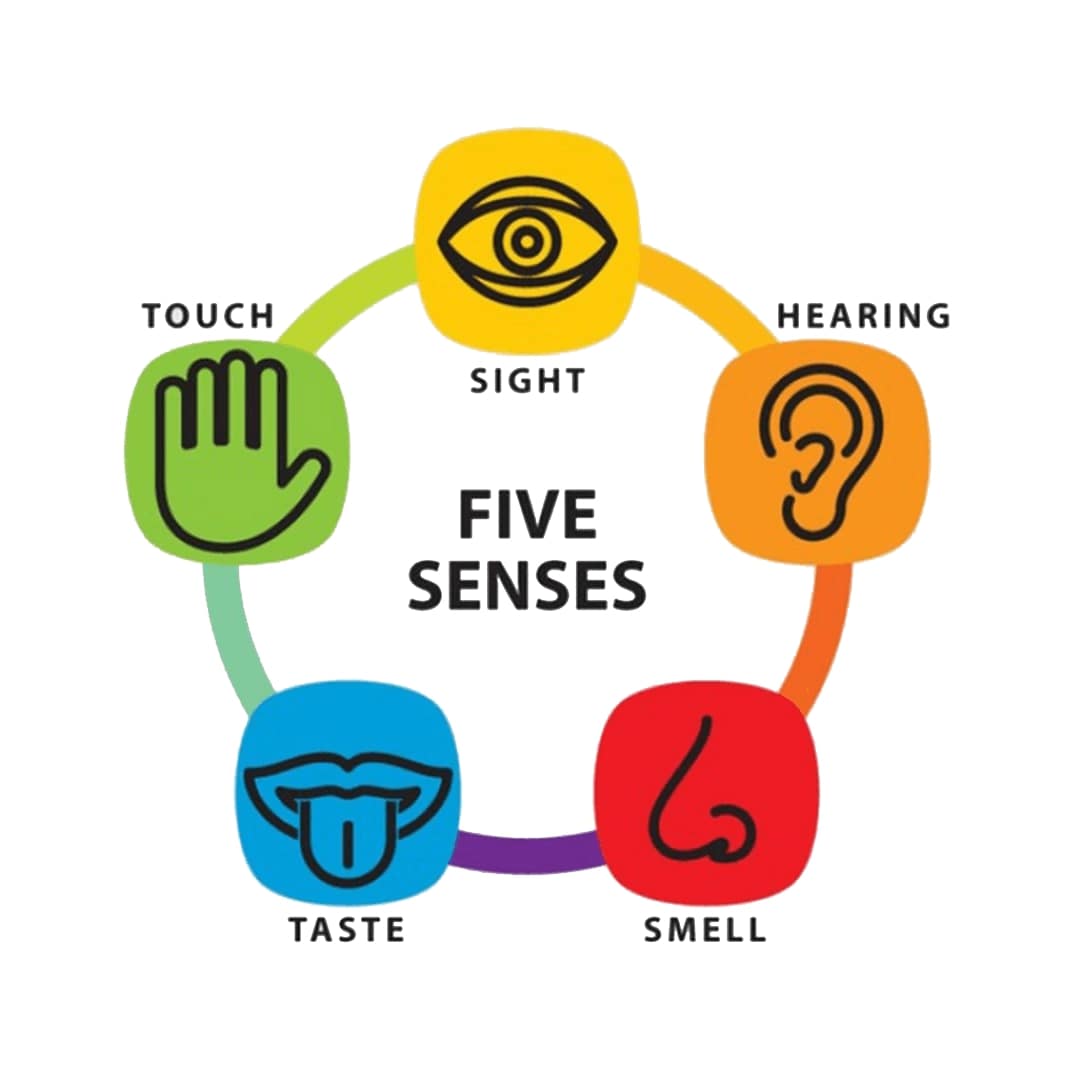
Practical Tips
With our recommendations on how to structure your tour scripts and writing tips, we’re sure that you have all the necessary tools to write good tour scripts for your own tour. Now you are going to jump into writing and finish your first draft!
Before finalizing your work, we recommend you should do the follow practical tips to make sure your tour script perfect and align with the goals that you set in the beginning:
- Making sure the tour guide writing is short and easy to understand: You should look at the length of your tour plan again and make sure it’s long enough to cover all the key spots.
- Before using it with a group, you should test the script: No matter how good you think your writing is, you need to try it out on real people. The fastest and most direct way to improve your script is to get comments from the audience. Try to solve their issues:
a. What is making them crazy: Provide more information b. Questions about the tour guide script: Prepare the answers to the questions ahead of time, because you might be asked similar ones on your real tour. c. Comments on how you present the material, the language you use, the interactive parts, the tone of voice, etc.: Think about them and improve them as needed
Practicing how to say the lines and how fast or slow to say them: Practice often. The more you practice, the more confident you will feel when you actually give the presentation to your customers.

Example of a Tour Guide Script
Example of good tour guide content: A tour guide script for a dinosaur tour, by REDPATH MUSEUM SOCIETY of McGill University.
The author put together his story in a way that makes sense and flows well. The main content is set up so that it tells you about each type of dinosaur in order. He used a story to explain to tourists why the dinosaurs died out. At the end, he told some fun stories about dinosaurs.
Here is the full tour guide script:
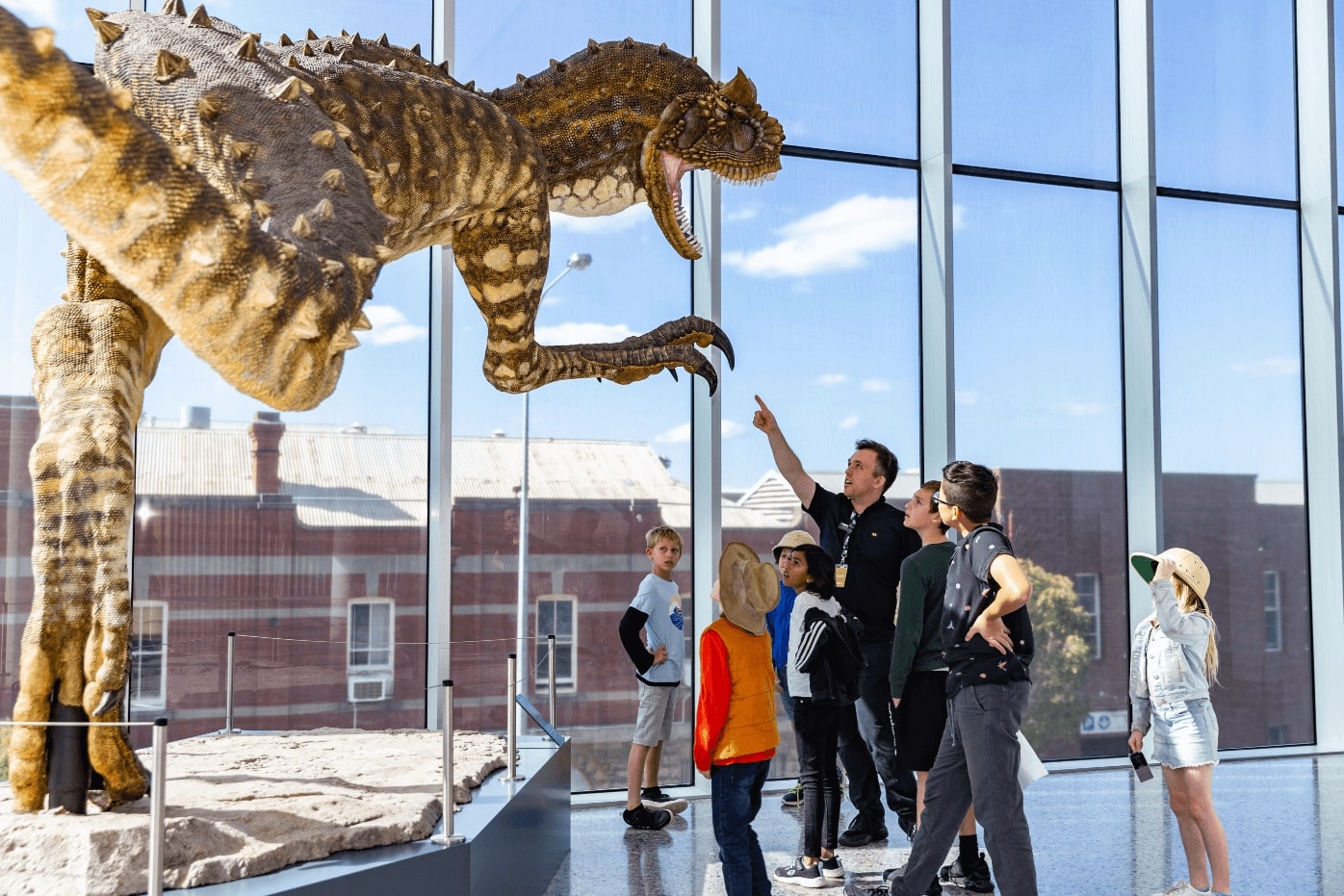
DINOSAUR TOUR
Location, 2nd floor, main gallery A note about the dinosaur bones: Most of the bones in the museum are plaster casts from actual bones – this is due to the fragility and value of actual bones. Real bones are made of rock and are therefore very heavy – they cannot be mounted in life-like poses the same way a lighter cast can. However, a plaster cast, as an exact replica of a real bone, is as good as originals.
The Gorgosaurus (formerly Albertosaurus): This Gorgosaurus, meaning ‘fierce lizard’, was first described in 1914 by Canadian paleontologist Lawrence Lambe. It is a smaller, slightly older cousin of the famous Tyrannosaurus rex. This specimen is a juvenile, probably equivalent to a human teenager, and is only two-thirds the adult size. Among the largest land predators ever to walk to planet, this animal had a colossal appetite. Razor-sharp teeth jaggedly arranged along its massive jaws, enormous jaw muscles that protruded from the extra holes you see in its skull and small but powerful forearms combined to enable theGorgosaurus to eat rapidly.
Stones called gastroliths were also used to further grind up meat were in the animal’s stomach. Gorgosaurus was very fast, probably moving along much like it is posed here. Look at the length of its tail relative to the rest of its body – contrary to so many years of dinosaur representation, they did not drag their tails along the ground, but rather used them for balance. How do we know this? There have been fossils of dinosaur track-ways discovered that have rows of feet, but no line between them to indicate a dragging tail.
The Thescelosaurus
The Thescelosaurus specimen on display in the Dawson gallery was collected from southern Saskatchewan in May 2008 by the McGill Vertebrate Paleontology Field School. This small, bipedal dinosaur was a herbivore, belonging to a large group of dinosaurs called the ‘ornithiopods’.Thescelosaurus are known only from the latest Cretaceous period of North America, dating back 65 million years to a time just before the extinction of the dinosaurs. This dinosaur would have lived alongside Tyrannosaurus rex, Triceratops, the duck-billed Edmontosaurus and several small species of theropod (bipedal carnivorous dinosaurs) like Saurornitholestes and Dromaeosaurus.
There are three known species of Thescelosaurus: Thescelosaurus assiniboiensis, Thescelosaurus neglectus and Thescelosaurus garbanii. This specimen likely belongs to Thescelosaurus assiniboiensis, which was newly described in 2012. The fossil comprises of an articulated vertebral column, a large portion of the rib cage, part of a scapula (shoulder blade) and a foot. After it was collected from the field, the specimen was leant to McGill under loan from the Royal Saskatchewan Museum. The long process of preparing the fossil out of its sandstone matrix took four years, but the effort was worth it!
The Dromaeosaurus :
The Dromaeosaurus (‘running lizard’), is a dinosaur species found mainly in Alberta. Despite their relatively small size, they were very successful pack hunters, often taking down prey much larger then themselves.
With their razor-like claws and teeth, and their fearsome speed, a group of these raptors could easily overcome a much larger dinosaur before it had time to react. One large dinosaur would make a handsome meal for a group of much smaller Dromaeosaurs. Like the Gorgosarus, these dinosaurs also had long tails that they most likely used to maintain balance while pursuing their prey. TheDromaeosaurus may have developed a form of society out of the necessity to compete with much larger predators.
The Archaeopteryx :
Archaeopteryx (‘ancient wing’) is the world’s oldest bird. Only ten fossils of this animal have ever been found, all from a place in Germany called Solenhofen. When the Archaeopteryx was first found, the feather impressions were accidental erased because the specimen was thought to be small carnivorous dinosaur. We now know that many small carnivorous dinosaurs also had feathers which were used, not for flight, but for insulation and/or sexual display.
Why have no dinosaur fossils been found in Quebec? While dinosaurs almost certainly roamed around parts of Quebec and Ontario, no fossils have been found in this area. The fossils we find in Montreal today are of the Ordovician era; 200 million years before dinosaurs evolved. Remember the famous ice caps that ravaged our territory a million years ago? The weight of the ice gouged away 450 million years of sedimentary rock, along with any fossils that were preserved within it. Alberta, Saskatchewan and Manitoba have undergone a different set of geological events and therefore the dinosaur-bearing rocks in these provinces are still intact.
What happened to the dinosaurs?
At the end of the Late Cretaceous period 65 million year ago, a huge meteorite crashed into the Gulf of Mexico, leaving a crater 100km across. It was likely not the impact itself that killed most of the animals and plants of the time, but the clouds of dust the collision threw up into the air. For as long as a hundred years, these clouds obscured the sunlight, affecting the whole food chain: first, the plants could no longer grow, next the herbivores could no longer eat, and then the carnivores ran out of food. The daily hours of sunlight had become too few for life to continue on its previous course. At this point, it is thought the far more resourceful mammals began to prosper, spread and diversify, leading to the eventual ascent of our own species. If the dinosaurs had never disappeared, it is unlikely that we would have had a chance against them. (information from Bruno Paul Stenson, M.A.)
Outline of Mesozoic Era: 248 to 65 million years ago
Triassic Period 248-206 MYA – The world was one major landmass called Pangea, it consisted of dry landscapes, gingkoes, ferns and cycads (similar to palms), but no flowering plants. Animals included the first dinosaurs and small early mammals. Jurassic Period 206-144 MYA – Pangea split into a northern continent (Laurasia) and a southern continent (Gondwana). It was a more humid and cooler climate than before with conifers, cycads, tree ferns and gingkoes, but probably no flowering plants. Cretaceous Period 114-65 MYA – Continents split further and North America is split by a shallow sea extending from Hudson Bay to the Gulf of Mexico. Western North America connected to eastern Asia and the climates were seasonal. The first flowering plants were becoming more dominant than conifers and cycads. Grasses were not yet present, as this type of plant did not evolved until the Cenozoic age. More species of dinosaurs evolved during the Cretaceous period than during the Triassic and Jurassic periods combined.
Interesting Dinosaur Facts :
- Physiology: Like mammals, most dinosaurs could walk and breath at the same time. Most other reptiles can’t do this because the muscles that control their limbs are also associated with their breathing.
- Senses: Therapods (all carnivorous dinosaurs) had well developed eyes and vision centres in the brain, suggesting they relied on sight to locate prey. Some plant eaters seem to have relied on smell to detect predators.
- Feeding: Sauropods (‘long-necked dinosaurs’) used stones in their gizzards to grind down plant matter swallowed whole. Ceratopsians (horned dinosaurs) used grinding teeth. Therapods (all carnivorous dinosaurs) had large heads, blade-like teeth, and an extra joint in the jaw to accommodate large pieces of food.
- Sexual Dimorphism: Paleontologists speculate that Tyranosaurus rex males were grassile, while the females were heavier. Some hadrosaurs (‘duck-billed dinosaurs’) males may have had long head crests, while females had shorter ones. In Protoceratops ( a small horned dinosaur), the males had large frills while the females appear to have had smaller ones.
- Speed: Short femur (thigh bone) and long tibia (shin bone) are indicators of a fast runner. Small therapods had disproportionately long legs built for speed and could reach speeds up to 25 kph. Because of their large size, larger therapods we slower, reaching speeds of about 15 kph. Sauropods were slow and were incapable of running.
- Social Groupings: Large therapods (carnivorous dinosaurs)may have been solitary or moved in pairs, although there is also evidence that they may have hunted in packs. Small therapods moved in groups of tens of individuals. Sauropods moved in groups of a dozen. Ceratopsians moved in herds of hundreds or thousands.
You are at the end of this article. There are so many things to learn and practice right? We agree that writing a good tour guide script is not an easy task. Let’s summarize what you have learned so far! We have gone through step-by step instructions to write a good tour guide script.
- Researching the destination
- Understand the target audience
- Structuring the script
- Writing techniques
- Practical tips
- Example of good tour guide script
We hope the article helps. And we believe that by implementing these strategies, tips and advice that we provided, you can create your own tour guide script that amazes your tourists.

Unleash The Full Potential of Your Travel Agency Website with Traveler
- NEW VERSION 3.1.1 – Upsell and Trust Badges For Partner by traveler 16/11/2023
- How to Increase Bookings for Your B&B? by traveler 13/09/2023
- NEW VERSION 3.1.0 – New Update Solo Tour Demo, Mega Menu, Upsell Power and Trust Badges by traveler 11/09/2023
- How To Optimize Blog Content for Your Bed & Breakfast Business? by traveler 10/09/2023
- Top 5 Ways to Advertise Your Bed and Breakfast Business by traveler 10/09/2023
Related Posts
How to increase bookings for your b&b, how to optimize blog content for your bed & breakfast business, top 5 ways to advertise your bed and breakfast business.
- Privacy Policy
- Support Policy
- Refund policy
- Term and Conditions
Traveler design by ShineCommerce © All rights reserved
- How to write an audio guide tour script
Need to know how to write an audio guide tour script for tourist visitor attractions? I’ve written several scripts for audio guides and visitor interpretation. Here are some tips on how to create an engaging experience for listeners.
Get to know the site or building
As a first step, get hold of any available leaflets, interpretation or background for the project. Do some research. Then, go on a recce of the site you’re writing the guide for. Ideally, do this with the curator, or the client who has commissioned the audio guide. If you’re creating a tour by yourself, you’ll need to plan the flow of the tour, start and end process, and listening points. Keep it simple, and not too long. Clients should have an idea of the right length of guide for their typical visitors.
Record your visit and story points
Take a well-charged camera or phone for photos. I also record video of any story and transition points, and scans of the rooms. This is essential for orientation when you’re writing a tour. Take pictures of key objects in the displays which are likely to be focal points, story ‘nodes’ or listening stations. If anything strikes you as a good story, take a photo. Take pictures of architectural or landscape features, too.
As a new visitor to the attraction, you’re in a great position to notice what will strike and appeal to other visitors. I like to record audio, too, as curators and desk staff are very good at explaining exhibits in language you can use. Also, it’s hard to take everything in on a first visit, and tricky to write notes on the hoof.
Establish the audience and access needs
Will the tour be for adults? Children? Find out the target age range, as this will have a bearing on your writing style and content. Will listeners include overseas visitors? Will the guide be translated into other languages? You’ll need to bear this in mind when writing about cultural references – what may be familiar history to you may be far from obvious to non-local or younger visitors.
Will the tour be indoors, outdoors, or a mix? What areas will visitors have access to? What’s underfoot – stony paths, turf, narrow stairways, bridges? Visitors may have prams, or mobility or sight issues. Ask your guide how visitors engage with the space, and about any changes up ahead that need to be incorporated.
Decide what story you’re telling
Is it the story of the place? Of the building? Of someone who lived there? A family? Another group of people? Maybe it’s an outdoor story interpreting the natural world? Or it’s on a larger scale, such as a town or video tour? Sometimes this is clear, and will give you a good throughline.
Sometimes, even with venues associated with a historical character, you might find several dimensions in play at once. For example, I wrote a linear tour for Mary, Queen of Scots House in Jedburgh, telling the story of the Queen’s visit to the town. It also had to incorporate the regional context, and architectural features. So, we used two narrative layers – a general narrator with a third person viewpoint, and the first-person viewpoint in the character of the Queen.
Ask if the audio guide tour script is linear or non-linear
This will affect what and how you write the guide. Some audio guides are linear tours which have a set length, sequence and number of clips. This kind may be used when there’s a limit on visitor capacity, and the organisers need a tour structure, to keep visitor flow moving. Other guides are non-linear, and visitors have a choice of what to listen to, how long, and in what order. They usually have listening points with numbers or QR codes which allow visitor to find the right audio clip. This kind are often found in galleries, where visitors can’t possibly see everything on a single visit, and have different subject interests.
For tour scripts with a live guide or performer, check out this article on how to write an interactive storytelling script .
Choose listening points and focal points
Choose locations and objects where people can stand and listen safely, without causing logjams. With linear tours, you’ll also need to factor in time for people to move between points. I’ve usually written linear tours at 30-40 minutes, no more, though it depends on the scale of venue. Any longer is a substantial time for visitors to be on their feet.
You and the curator will have to make tough choices about what to focus on. Listeners can only take in so much, and have background noise and movement to contend with. An actual object that can be seen is often a stronger choice than a story about something that can’t be seen. In historical buildings, the building itself might be the story – a mediaeval toilet, a left-handed staircase.
It’s good to begin each new listening point with a line of context to help the listener to pull focus – “You’re now standing in front of/ this is the oldest tree in the forest/ the King’s Bedroom/ a wonderful example of Art Nouveau painting”. See my article on attunement in audio writing .
Discuss writing parameters and production budget
Most audio tours are simplest to write from a traditional, third person narrator viewpoint. But it can also be fun to write a character viewpoint. I once wrote a historic jail tour from the jailer’s perspective. We were able to dramatize his character, have him talk about prisoners, and even ring the prisoner escape bell. This kind of character can use direct address to the listener and breach the fourth wall, which is fun. Some audio guides use dramatized dialogue between characters, which feels more like eavesdropping.
These choices have a bearing on budget and casting, so make sure you’ve agreed this before you start to write. It’s a good idea also ask about music and sound effects, as you can write these in. It’s best to keep this as simple and uncluttered as possible, as listeners will be moving around, often with background noise, which can make it hard to hear highly nuanced sound. I usually suggest just some mood-setting production music, and sometimes background sound effects – ideas such as rowdy crowds or courtly music can be good for populating empty spaces.
It’s a good idea to ask the curator about local musicians and voice talent, especially with historical venues. Authentic music and voices are a great asset to an audio tour, and production companies may not be as thoughtful about local choices, if the job is just one of many.
Clarify credits, wordings, costings
Ask which organisations, funders and contributors have to be acknowledged. If you’re unfamiliar with any mentioned people or place names, record the curator’s pronunciation. This will be useful for briefing the production company later on.
On costings, I suggest quoting a package cost based on days spent. Agree the job scope – the number of listening points, length and number of words – and any extra jobs, including research or music sourcing. Keep it simple. You’re not being asked to research the entire backstory of the project, as your client should be able to give you this information. Agree a rough running order and ask them to fill in the main bullet points. Any research gaps in your first draft can be filled in by your client – it’s far quicker for them to do this, with their subject expertise, than for you to reinvent the wheel. Allow for two or three rounds of feedback on drafts.
For my most recent audio tour at Mary, Queen of Scots Visitor Centre, I was lucky enough to work with lovely German translation colleague Änne Russell – see her blog and visitor comments .
Are you interested in scripts for storytelling, guided walks and live visitor interpretation? See my article on how to write an interactive storytelling script .

Read more articles on writing for the ear: Recording an audiobook – the magic of attunement Podcasting – writing for audio first on The Creative Penn How to prepare a non-fiction book for audio recording Writing for Audiobooks
Share with friends
Latest posts.
- Authors: do you have ‘too many writing ideas’ syndrome?
- Strategic UX writing – how to handle a website restructure
- How to prepare a non-fiction book for audio recording
- How to write a nanonovel with random writing prompts
- Using Oblique Strategies in writing and creativity
- AI and generative writing with GPT-3
By clicking the Accept button, you agree to our privacy policy regarding cookies, tracking statistics, etc.
Manage cookies
- All Moscow Hotels
- Most Popular
- Hotels by Class
- Quick Search
- Request Best Rates
- Recommended Hotels
- Event Planning Tips
- Moscow Meeting Space
- Request a Proposal
- Group Travel Info
- Russian Visa Info
- Request Visa Support
- Airport Transfers
- Airline & Rail Tickets
- St. Petersburg Hotels
Cosmos Hotel
Which is the nearest metro station.
Expedia Rewards is now One Key™
Find hotels in elektrostal.
Most hotels are fully refundable. Because flexibility matters.
Save 10% or more on over 100,000 hotels worldwide as a One Key member.
Search over 2.9 million properties and 550 airlines worldwide.
Pet friendly
Fully refundable
Reserve now, pay later
Bed & breakfast
Breakfast included
Lunch included
Dinner included
All inclusive
Golf course
WiFi included
Electric car charging station
Outdoor space
Air conditioned
Washer and dryer
Airport shuttle included
Wheelchair-accessible parking
Accessible bathroom
Service animals allowed
In-room accessibility
Sign language-capable staff
Roll-in shower
Stair-free path to entrance
LGBTQ welcoming
See properties that pledge to make all guests feel safe, welcome, and respected.
Business friendly
See properties with amenities to help you work comfortably, like WiFi and breakfast.
Family friendly
See properties that include family essentials like in-room conveniences and activities for the kids.
Compare hotels, room rates, hotel reviews and availability. Most hotels are fully refundable.
Stay near popular elektrostal attractions, electrostal history and art museum.
You can spend time exploring the galleries in Electrostal History and Art Museum in Elektrostal. Take in the museums while you're in the area.
Elektrostal Travel Info
Frequently asked questions.
Yes! The majority of room reservations are refundable if you cancel prior to the hotel's cancellation deadline, which is often 24 or 48 hours before your check-in date. If you have a non-refundable reservation, you might still have the option to cancel and receive a refund within 24 hours of booking. Filter your search by fully refundable to find flexible hotel deals in Elektrostal.
To access more information about rescheduling or cancelling your trip to Elektrostal, head over to our customer service page .
Apart Hotel Yantar is one of the top choices for your stay based on our traveler data, and this 3-star hotel offers free parking and free WiFi. It's located 1.9 mi (3 km) from Electrostal History and Art Museum. Another good option is Apartments , located 4.6 mi (7.4 km) away.
Hotel Mys Otdykha Nadezhda : Offers spa services, an indoor pool, and free parking. Park Hotel Yahonty Noginsk and Areal Congress Hotel are a couple of other choices that feature an onsite pool.
Visitors can enjoy all that Elektrostal has to offer including its museums. There are 35 hotels and other accommodations in the surrounding area. Find out more about Elektrostal .
A favorite place to visit is Electrostal History and Art Museum . You'll also find History of Russian Scarfs and Shawls Museum and Central Museum of the Air Forces at Monino in the area. Check out what more to see and do in Expedia's Elektrostal guide .
The hottest months are usually July and August with an average temp of 63°F, while the coldest months are January and February with an average of 22°F. The snowiest months in Elektrostal are December, November, February, and January, with each month seeing an average of 38 inches of snowfall.
- Explore a world of travel with Expedia
- Yuri Gagarin Cosmonaut Training Center
- Peter the Great Military Academy
- Balashikha Arena
- Bykovo Manor
- Malenky Puppet Theater
- Military Technical Museum
- Drama Theatre BOOM
- Fryazino Centre for Culture and Leisure
- Likino Dulevo Museum of Local Lore
- Shirokov House
- Borisoglebsky Sports Palace
- Fifth House Gallery
Hotels near Elektrostal Airports
- Bykovo Airport
- Sheremetyevo Airport
- Domodedovo Intl. Airport
- Vnukovo Intl. Airport
- Chkalovsky Airport Airport
- Zhukovsky Airport
Other Hotels near Elektrostal, Moscow Oblast
- Northern Europe Hotels
- Eastern Europe Hotels
- Lyubertsy Hotels
- Ramenskoye Hotels
- Balashikha Hotels
- Noginsk Hotels
- Central Russia Hotels
- Kosherovo Hotels
- Zheleznodorozhny Hotels
- Shchelkovo Hotels
- Malakhovka Hotels
- Ogudnevskoe Hotels
- Fryazevo Hotels
- Istomkino Hotels
- Peshkovo Hotels
- Imeni Vorovskogo Hotels
- Berezka Hotels
- Afonasovo Pervoye Hotels
- Bol'shoye Bun'kovo Hotels
- Pavlovskiy Posad Hotels
Expedia's Latest Trends
km travel chesterfield 2024 brochure prices
This is our KM Travel Tour Operators page, we have listed the full address of KM Travel as well as phone numbers and websites. KM Travel is in Chesterfield, KM Travel may offer holiday tours, sightseeing tours, and general city tours in Chesterfield.
If you have used KM Travel before be sure to leave your own comment or rating on the city tour or holiday tour that you went on so other poeple wishing to use this company can read fair and honest reviews before the book there holiday with KM Travel. Please remember that KM Travel may offer much more that just UK holiday tours, UK Coach Tours and city tours so remember to contact the travel agents company using the details below to find out more information.
Latest KM Travel Reviews

- Transportation (Chesterfield)
- KM Travel Chesterfield
Chesterfield, United Kingdom
Related places.
- Get directions
- Photos page
QR code, vCard

Activate map
Business hours
Reviews of km travel chesterfield.
- Things to Do
- Restaurants
- Holiday Rentals
- Travel Stories
- Add a Place
- Travel Forum
- Travellers' Choice
- Help Centre
Lovely holiday - KM British & European Coach Holiday
- Europe
- United Kingdom (UK)
- England
- Yorkshire
- South Yorkshire
- Barnsley
- Barnsley - Things to Do
- KM British & European Coach Holiday
Brilliant holiday to Torquay, tinsel & turkey 20 th November to Belgrave Sands hotel. The hotel was... read more
Thanks to all at KM TRAVEL especially our driver courier Matt who made the trip more enjoyable and... read more
Trains Moscow to Elektrostal: Times, Prices and Tickets
- Train Times
- Seasonality
- Accommodations
Moscow to Elektrostal by train
The journey from Moscow to Elektrostal by train is 32.44 mi and takes 2 hr 7 min. There are 71 connections per day, with the first departure at 12:15 AM and the last at 11:46 PM. It is possible to travel from Moscow to Elektrostal by train for as little as or as much as . The best price for this journey is .
Get from Moscow to Elektrostal with Virail
Virail's search tool will provide you with the options you need when you want to go from Moscow to Elektrostal. All you need to do is enter the dates of your planned journey, and let us take care of everything else. Our engine does the hard work, searching through thousands of routes offered by our trusted travel partners to show you options for traveling by train, bus, plane, or carpool. You can filter the results to suit your needs. There are a number of filtering options, including price, one-way or round trip, departure or arrival time, duration of journey, or number of connections. Soon you'll find the best choice for your journey. When you're ready, Virail will transfer you to the provider's website to complete the booking. No matter where you're going, get there with Virail.
How can I find the cheapest train tickets to get from Moscow to Elektrostal?
Prices will vary when you travel from Moscow to Elektrostal. On average, though, you'll pay about for a train ticket. You can find train tickets for prices as low as , but it may require some flexibility with your travel plans. If you're looking for a low price, you may need to prepare to spend more time in transit. You can also often find cheaper train tickets at particular times of day, or on certain days of the week. Of course, ticket prices often change during the year, too; expect to pay more in peak season. For the lowest prices, it's usually best to make your reservation in advance. Be careful, though, as many providers do not offer refunds or exchanges on their cheapest train tickets. Unfortunately, no price was found for your trip from Moscow to Elektrostal. Selecting a new departure or arrival city, without dramatically changing your itinerary could help you find price results. Prices will vary when you travel from Moscow to Elektrostal. On average, though, you'll pay about for a train ticket. If you're looking for a low price, you may need to prepare to spend more time in transit. You can also often find cheaper train tickets at particular times of day, or on certain days of the week. Of course, ticket prices often change during the year, too; expect to pay more in peak season. For the lowest prices, it's usually best to make your reservation in advance. Be careful, though, as many providers do not offer refunds or exchanges on their cheapest train tickets.
How long does it take to get from Moscow to Elektrostal by train?
The journey between Moscow and Elektrostal by train is approximately 32.44 mi. It will take you more or less 2 hr 7 min to complete this journey. This average figure does not take into account any delays that might arise on your route in exceptional circumstances. If you are planning to make a connection or operating on a tight schedule, give yourself plenty of time. The distance between Moscow and Elektrostal is around 32.44 mi. Depending on the exact route and provider you travel with, your journey time can vary. On average, this journey will take approximately 2 hr 7 min. However, the fastest routes between Moscow and Elektrostal take 1 hr 3 min. If a fast journey is a priority for you when traveling, look out for express services that may get you there faster. Some flexibility may be necessary when booking. Often, these services only leave at particular times of day - or even on certain days of the week. You may also find a faster journey by taking an indirect route and connecting in another station along the way.
How many journeys from Moscow to Elektrostal are there every day?
On average, there are 71 daily departures from Moscow to Elektrostal. However, there may be more or less on different days. Providers' timetables can change on certain days of the week or public holidays, and many also vary at particular times of year. Some providers change their schedules during the summer season, for example. At very busy times, there may be up to departures each day. The providers that travel along this route include , and each operates according to their own specific schedules. As a traveler, you may prefer a direct journey, or you may not mind making changes and connections. If you have heavy suitcases, a direct journey could be best; otherwise, you might be able to save money and enjoy more flexibility by making a change along the way. Every day, there are an average of 18 departures from Moscow which travel directly to Elektrostal. There are 53 journeys with one change or more. Unfortunately, no connection was found for your trip from Moscow to Elektrostal. Selecting a new departure or arrival city, without dramatically changing your itinerary could help you find connections.
Book in advance and save
If you're looking for the best deal for your trip from Moscow to Elektrostal, booking train tickets in advance is a great way to save money, but keep in mind that advance tickets are usually not available until 3 months before your travel date.
Stay flexible with your travel time and explore off-peak journeys
Planning your trips around off-peak travel times not only means that you'll be able to avoid the crowds, but can also end up saving you money. Being flexible with your schedule and considering alternative routes or times will significantly impact the amount of money you spend on getting from Moscow to Elektrostal.
Always check special offers
Checking on the latest deals can help save a lot of money, making it worth taking the time to browse and compare prices. So make sure you get the best deal on your ticket and take advantage of special fares for children, youth and seniors as well as discounts for groups.
Unlock the potential of slower trains or connecting trains
If you're planning a trip with some flexible time, why not opt for the scenic route? Taking slower trains or connecting trains that make more stops may save you money on your ticket – definitely worth considering if it fits in your schedule.
Best time to book cheap train tickets from Moscow to Elektrostal
The cheapest Moscow - Elektrostal train tickets can be found for as low as $35.01 if you’re lucky, or $54.00 on average. The most expensive ticket can cost as much as $77.49.
Find the best day to travel to Elektrostal by train
When travelling to Elektrostal by train, if you want to avoid crowds you can check how frequently our customers are travelling in the next 30-days using the graph below. On average, the peak hours to travel are between 6:30am and 9am in the morning, or between 4pm and 7pm in the evening. Please keep this in mind when travelling to your point of departure as you may need some extra time to arrive, particularly in big cities!
Moscow to Elektrostal CO2 Emissions by Train

Anything we can improve?
Frequently Asked Questions
Go local from moscow, trending routes, weekend getaways from moscow, international routes from moscow and nearby areas, other destinations from moscow, other popular routes.
Na Ulitse Yalagina 13B Apartments

Trending Questions
Property policies, frequently asked questions, how much does it cost to stay at na ulitse yalagina 13b apartments, what are the check-in and check-out times at na ulitse yalagina 13b apartments, does na ulitse yalagina 13b apartments provide airport transfer services, what amenities and services does na ulitse yalagina 13b apartments have, does na ulitse yalagina 13b apartments have a swimming pool, does na ulitse yalagina 13b apartments have fitness amenities, does na ulitse yalagina 13b apartments provide wi-fi, does na ulitse yalagina 13b apartments have non-smoking rooms, does na ulitse yalagina 13b apartments have a restaurant, is parking available at na ulitse yalagina 13b apartments, popular hotels, popular attractions, explore more.
Expedia Rewards is now One Key™
Elektrostal, visit elektrostal, check elektrostal hotel availability, popular places to visit.
- Electrostal History and Art Museum
You can spend time exploring the galleries in Electrostal History and Art Museum in Elektrostal. Take in the museums while you're in the area.
- Cities near Elektrostal

- Places of interest
- Yuri Gagarin Cosmonaut Training Center
- Peter the Great Military Academy
- Central Museum of the Air Forces at Monino
- History of Russian Scarfs and Shawls Museum
- Balashikha Arena
- Balashikha Museum of History and Local Lore
- Bykovo Manor
- Pekhorka Park
- Ramenskii History and Art Museum
- Malenky Puppet Theater
- Drama Theatre BOOM
- Likino Dulevo Museum of Local Lore
- Noginsk Museum and Exhibition Center
- Pavlovsky Posad Museum of Art and History
- Saturn Stadium
- Fairy Tale Children's Model Puppet Theater
- Fifth House Gallery
- Church of Vladimir
- Malakhovka Museum of History and Culture
- Orekhovo Zuevsky City Exhibition Hall
Destinations in May
Destinations in 2024.
Please note prices are based on two persons sharing a twin/double room. Single room supplements may apply, please call check single availability/price.
Comments are closed.
- Destinations
- Hotel Information
- Private hire
- Special offers / Late availability
- Travel Insurance
- Employment Opportunities

NEW CHRISTMAS TOUR 2024 - Bournemouth - Norfolk Royale Hotel - BROCHURE ADDITION . 2024 EUROPEAN HOLIDAYS - Early release - ITALY - Lake Garda / Alassio Click here to download our 2024 Brochure All Our Holidays Include In The Price: Free Door to Door Taxi ( Subject to Area ) ~ Luxury Coach Travel ~ Reserved Coach Seats . Personally Selected ...
www.kmchesterfield.co.uk
KM Travel of Barnsley, South Yorkshire. Request a brochure by: Calling: 01226 245564 email: [email protected] . download: click here to download the 2024 Tour Brochure.
KM Travel is in Chesterfield, KM Travel may offer holiday tours, sightseeing tours, and general city tours in Chesterfield. If you have used KM Travel before be sure to leave your own comment or rating on the city tour or holiday tour that you went on so other poeple wishing to use this company can read fair and honest reviews before the book ...
What people are saying. " HOLIDAY TO BLACKPOOL ". Oct 2023. Thanks to all at KM TRAVEL especially our driver courier Matt who made the trip more enjoyable and a credit to the co... " Lovely place enjoyed it clean need a bit of investment there ". Aug 2022. Stayed at ilfracombe Devon 14 to 20 Aug the coach was lovely our driver Tony was ...
Reviews, contact details and business hours of KM Travel Chesterfield at 27 Stephenson Place, Chesterfield, Derbyshire. Check out nearby places on a map. Write a review. Log in. ... 21:03 Tuesday, 23 April 2024: Business hours. Monday: 9:00 am - 4:30 pm: Tuesday: 9:00 am - 4:30 pm: Wednesday: 9:00 am - 4:30 pm: Thursday: 9:00 am - 4:30 ...
KM Travel of Barnsley, South Yorkshire. Tel: (01226) 245564 [email protected] . Home. Booking Guide Request Brochure Customer Information Contact Us. ... Our 2024 British Coach Holiday Brochure is now available to download and available shortly from our Market Street office in paper form.
5. £339. Nil. Please note prices are based on two persons sharing a twin/double room. Single room supplements may apply, please call check single availability/price. Price Includes: * Luxury Coach Travel * Local Departure Points. * En-suite bedrooms * Excursions. * Half Board Accommodation.
Page List. (Click on the page required to be linked with that page in the brochure) Page 1 - Front cover. Page 2 - Introduction. Page 3 - Contact information. Customer information. Page 4 - How to make a booking. Holiday index January to June. Page 5 - Holiday index June to December.
Our 2024 UK Brochure is OUT NOW! Order yours today. 01246 474747 Opening Times Brochures . Menu (current) Home Holidays Day Trips ... A-Line Travel 15 Soresby Street Chesterfield S40 1JW 01246 474747 [email protected] . A-Line Travel, Company number 13060548
Lovely holiday. Review of KM British & European Coach Holiday. Reviewed 9 December 2023. Just back from a T&T break at Exmouth. The hotel and food were brilliant, and the driver James was the best. However we had a bad start after waiting nearly one and a half hours in cold and rain at Ilkeston for the coach. I know there was traffic problems ...
Geeveetravelchesterfield, Chesterfield. 1,657 likes · 24 talking about this · 29 were here. DOOR TO DOOR COACH HOLIDAYS DAY TRIPS AND PRIVATE HIRE
Thankyou received our brochure in the post , I see you have new for 2024 Kynren weekend , we went last year and its the most amazing show I've seen well worth going recommended to everybody. 22w. Robert Lindley. Can I have a brochure please 9 monsal crescent Barnsley S71 3PY. 15w.
KM Travel of Barnsley, South Yorkshire. Tel: (01226) 245564 [email protected] . Home. Booking Guide Request Brochure Customer Information Contact Us. Skip to content. Request a brochure by: Calling: 01226 245564 . email: [email protected] download: ... Please note prices are based on two persons sharing a twin/double room ...
Central Air Force Museum The Central Air Force Museum, housed at Monino Airfield, 40 km east of Moscow, Russia, is one of the world's largest aviation museums, and the largest for Russian aircraft. 173 aircraft and 127 aircraft engines are on display, and the museum also features collections of weapons, instruments, uniforms (including captured U2 pilot Gary Powers' uniform), other Cold War ...
The journey from Moscow to Elektrostal by train is 32.44 mi and takes 2 hr 7 min. There are 71 connections per day, with the first departure at 12:15 AM and the last at 11:46 PM. It is possible to travel from Moscow to Elektrostal by train for as little as or as much as . The best price for this journey is . Journey Duration.
KM Travel of Barnsley, South Yorkshire. Tel: (01226) 245564 [email protected] . ... we guarantee excellent customer service and affordable prices. ... Winter/Spring 2024. Blackpool 2024 Potters Resorts 2024. Our booking office is located at: 52, ...
2022 Brochure . Page List ... All Our Holidays Include In The Price: Free Door to Door Taxi ( Subject to Area ) ~ Luxury Coach Travel ~ Reserved Coach Seats . Personally Selected Hotels ~ En-suite Bedrooms ~ Free Varied Excursions . Telephone: 01246 -556617 ...
Prices at Na Ulitse Yalagina 13B Apartments are subject to change according to dates, hotel policy, and other factors. To view prices, please search for the dates you wish to stay at the hotel. What are the check-in and check-out times at Na Ulitse Yalagina 13B Apartments? The check-in time is after 14:00 and the check-out time is before 12:00.
Cities near Elektrostal. Places of interest. Pavlovskiy Posad Noginsk. Travel guide resource for your visit to Elektrostal. Discover the best of Elektrostal so you can plan your trip right.
Sundance Institute Announces 2024 Fellows for Native, Directors and Screenwriters Labs
By Lexi Carson
Lexi Carson
- Gold House Launches ‘Gold Lights’ Initiative, Releases A100 List and Honors Lucy Liu and Padma Lakshmi – Film News in Brief 10 hours ago
- Kesha Joining Kylie Minogue and Janelle Monáe as a WeHo Pride Headliner (EXCLUSIVE) 14 hours ago
- Brian McCardie, ‘Line of Duty’ Actor, Dies at 59 14 hours ago

The Sundance Institute , a mentorship program dedicated to providing a space for artists and storytellers to create media, has selected 16 fellows for this year’s Directors, Screenwriters, and Native Labs.
Spanning over four decades, the Sundance Institute’s labs have provided new filmmakers a hands-on experience to create their own work with the help and guidance of creative advisers.
Popular on Variety
The Directors Lab is led by artistic director Gyula Gazdag and will take place in Stanley Hotel in Estes Park, Colo. from May 7 to 22. During this lab, fellows will engage in workshops to shoot and edit scenes from the original screenplays. They will also practice directing actors, revising their script and honing their visual style. The advisor cohort includes Miguel Arteta, Joan Darling, Rick Famuyiwa, Stephen Goldblatt, Keith Gordon, Reinaldo Marcus Green, Andrew Haigh, Randa Haines, Ed Harris, Siân Heder, André Holland, Karyn Kusama, Pam Martin, Estes Tarver and Dylan Tichenor.
Led by artistic director Howard Rodman, the Screenwriters Lab will be held online from June 4 to 7, where fellows will polish their scripts in individual story sessions with screenwriter advisors. The advisor cohort includes John August, Scott Z. Burns, Reggie Rock Bythewood, Scott Frank, Susannah Grant, Tamara Jenkins, Meg LeFauve, Jenny Lumet, Josh Marston, Kemp Powers, Robin Swicord and Joan Tewkesbury.
Notable graduates of the Sundance Institute labs include Quentin Tarantino, Darren Aronofsky, Paul Thomas Anderson, Andrew Ahn, Gregg Araki, Lisa Cholodenko, Ryan Coogler, Nia DaCosta, the Daniels, Rick Famuyiwa, Sydney Freeland and David Gordon Green.
The 2024 Sundance Institute Native Lab fellows are:
Don Josephus Raphael Eblahan (Writer-Director) with Hum (Philippines, U.S.A.): Haunted by the six-year absence of her missing husband, Esther, a single mother who works as a tour guide for mountaineers, embarks on her own treacherous journey of searching for him in the jungle where he had retreated to live with the beasts.
Don Josephus Raphael Eblahan is a filmmaker from the Philippines. Eblahan’s works explore
themes of trauma, spirituality, and nature, told through the cosmic lens of post-colonial spaces
and Indigenous identities. His film The Headhunter’s Daughter was awarded the Short Grand Jury Prize at the 2022 Sundance Film Festival.
Ryland Walker Knight (Writer-Director) with The Lip of the World (U.S.A.): When Cassandra discovers a young Indigenous woman washed ashore with no memory, the pair journey into the violent underworld of the Northern California psychedelic culture to uncover her true identity.
Ryland Walker Knight is a Cherokee writer and a filmmaker, and once upon a time he was called a film critic. An avid basketball and audiobook enthusiast, Knight lives and works in Oakland and Los Angeles, California.
Charine Pilar Gonzales (Writer-Director) with NDN Time (U.S.A.): A Tewa college student must master her new dimension-bending abilities to expose the nuclear secrets threatening her Pueblo.
Charine Pilar Gonzales wrote and directed the short films River Bank (Pō-Kehgeh) and Our
Quiyo: Maria Martinez . She co-produced the 2024 Sundance Film Festival short doc Winding Path . A Tewa filmmaker from San Ildefonso Pueblo and Santa Fe, New Mexico, she aims to
intertwine memories, dreams, and truths through story.
Lindsay McIntyre (Writer-Director) with The Words We Can’t Speak (Canada): A terrible Arctic accident leaves an Inuk interpreter unwelcome in her community. She is forced to weather impossible conditions and hateful prejudices, yet still care for her daughter, when she embarks on a dangerous 1,000-mile journey by dog sled with an inexperienced RCMP constable who fancies her for his wife.
Lindsay McIntyre (Inuit/settler) is a filmmaker whose works explores themes of portraiture, place, and personal histories. After 40+ experimental/documentary films and many festival awards, her recent leap into narrative with NIGIQTUQ ᓂᒋᖅᑐᖅ (2023) garnered her Best Short at imagineNATIVE and a chance at the Oscars. She teaches film at Emily Carr University of Art + Design.
The 2024 Sundance Institute Directors and Screenwriters Labs fellows are:
Keisha Rae Witherspoon is a Miami-born filmmaker whose short film T won the Golden Bear at the 2020 Berlinale. Keisha was named one of Filmmaker magazine’s “25 New Faces of Independent Film” in 2020 and is a 2022 USA Fellow. She is co-founder of Third Horizon Film Festival.
Jason Fitzroy Jeffers is a Barbadian filmmaker who has produced award-winning shorts such as Papa Machete and T , winner of the Golden Bear at the 2020 Berlinale. He is co-founder and former festival director of Third Horizon Film Festival, a 2023 USA Fellow, and a 2024 Creative Capital awardee. [Screenwriters Lab only]
Jane Casey Modderno (Writer-Director) with Here for the Weekend (U.S.A.): A rom-com about three trans girls questing for love in Palm Springs. It centers Cherry, a type-A hotel worker with dreams of launching a lingerie brand, and her seduction of a guest with the power to change her life… but only by ditching her friends.
Jane Casey Modderno wrote for Facebook’s The Birch and Peacock’s The Girl in the Woods . As director, her shorts have screened at festivals worldwide and are available to watch on Vimeo Staff Picks and Short of the Week.
Sylvia Khoury (Writer-Director) with I’m Heather (U.S.A.): Recently widowed Lebanese housewife Fadia, 60, dares to pursue a life outside the home by serving as a standardized patient for medical students to practice interacting with. Finding that Heather, the white character she plays, commands more respect than she does, Fadia begins to play at being Heather in her everyday life.
Sylvia Khoury received her MD from the Icahn School of Medicine in 2021 and is a 2022 Pulitzer Finalist in Drama ( Selling Kabul ). She is the Berlind Playwright-in-Residence at Princeton, commissioned by Lincoln Center and LAMF/Protozoa, and developing original TV shows with Plan B and at FX with the Js.
Kristine Gerolaga (Writer-Director) with Lamok (Philippines / U.S.A.): A Filipino woman determined to avenge the death of her daughter following a botched abortion finds her worldview dramatically altered after she is cursed to transform nightly into a fetus-eating creature known as the manananggal. [Screenwriters Lab only]
Kristine Gerolaga is a Filipina American filmmaker and actor. She is supported by The Future of Film is Female and Sundance Institute’s Artist Accelerator Program. Mosquito Lady , the proof-of-concept short for Lamok , had its world premiere at Beyond Fest and is now on the festival circuit.
Diana Peralta (Writer-Director) with No Love Lost (U.S.A.): When a troubled young woman brings her new husband home to meet the family, her devoted but insular sisters reveal the extremes they will go to protect one another.
Hanna Gray Organschi (Writer-Director) with Rubber Hut (U.S.A.): Rhode Island, 1992. An entrepreneurial ex–Pan Am stewardess opens a drive-thru condom shop in her Italian Catholic town. Overnight, Emanuella DelVecchio becomes the local lightning rod, a radical hero to the neighborhood teens and an unlikely threat to her tight-knit community.
Hanna Gray Organschi is a New England filmmaker pursuing her MFA at New York University. She received the NYWIFT scholarship, the Wasserman Award, and the Annenberg Inclusion Initiative Accelerator Grant and is on the 2024 Purple List. Her upcoming short F*ck That Guy is executive-produced by Spike Lee and Riva Marker.
Sara Crow (Co-Writer, Co-Director) and David Rafailedes (Co-Writer, Co-Director)with Satoshi (U.S.A.): The potentially true story of a teenage anime-obsessed hacktivist who, after losing her scholarship to Stanford, returns home to Arizona to become the mysterious inventor of a new digital currency called Bitcoin.
Sara Crow is a Brooklyn-based writer-director whose stories center misfits and subcultures. She is currently an MFA candidate at New York University’s Graduate Film Program, where she is a Martin Scorsese Scholar and the recipient of the Sloan Feature Film Award and the Sundance Institute Alfred P. Sloan Fellowship.
David Rafailedes is a bicoastal (Hudson River/Lake Erie) based writer-director. He attends New York University’s Graduate Film Program. He is also the co-playwright of Cellino v. Barnes and the recipient of the Sloan Feature Film Award and the Sundance Institute Alfred P. Sloan Fellowship.
Urvashi Pathania (Writer-Director) with Skin (U.S.A.): A horror-thriller about a dark-skinned Indian American woman tempted by an addictive and dangerous experimental skin bleaching machine — and the white woman who invented it. [Screenwriters Lab only]
Urvashi Pathania (she/her) is a writer-director based in Brooklyn. Her films explore gender, sexuality, and cultural bereavement. Pathania was selected for the 2023 Sundance Screenwriters Intensive with her feature Skin . She is also a recipient of the 2023 Sundance Horror Fellowship.
Claire Fowler (Writer-Director) with Toad (U.K.): After seeing a disturbing accusation online, a woman living far away from home and ostracized from her strikingly successful twin brother begins to piece together memories of the teen theater experience that came between them.
Claire Fowler is a writer and director from North Wales. She is an alum of Oxford University, Columbia University’s Film MFA, the WB Directors’ workshop, and the AFI’s Directing Workshop for Women. Her short Salam premiered at Tribeca and won a BAFTA Cymru, and she recently was a director on Netflix’s Manifest .
Ramzi Bashour is a filmmaker based in New York. He grew up in Beirut and over the years has worked as a cook, baker, journalist, and teacher. He’s written and directed award-winning shorts, including The Trees , and has collaborated as a composer and editor on feature films.
More From Our Brands
Nypd descends on columbia campus, arrests protesters, woodford reserve’s $1,000 mint julep cups are back, details matter: ncaa settling house and carter won’t end legal woes, be tough on dirt but gentle on your body with the best soaps for sensitive skin, monday ratings: all american posts season high in audience, sytycd eyes low, verify it's you, please log in.
- Share full article
For more audio journalism and storytelling, download New York Times Audio , a new iOS app available for news subscribers.

- April 30, 2024 • 27:40 The Secret Push That Could Ban TikTok
- April 29, 2024 • 47:53 Trump 2.0: What a Second Trump Presidency Would Bring
- April 26, 2024 • 21:50 Harvey Weinstein Conviction Thrown Out
- April 25, 2024 • 40:33 The Crackdown on Student Protesters
- April 24, 2024 • 32:18 Is $60 Billion Enough to Save Ukraine?
- April 23, 2024 • 30:30 A Salacious Conspiracy or Just 34 Pieces of Paper?
- April 22, 2024 • 24:30 The Evolving Danger of the New Bird Flu
- April 19, 2024 • 30:42 The Supreme Court Takes Up Homelessness
- April 18, 2024 • 30:07 The Opening Days of Trump’s First Criminal Trial
- April 17, 2024 • 24:52 Are ‘Forever Chemicals’ a Forever Problem?
- April 16, 2024 • 29:29 A.I.’s Original Sin
- April 15, 2024 • 24:07 Iran’s Unprecedented Attack on Israel
The Secret Push That Could Ban TikTok
U.s. lawmakers have long worried that the chinese government could use the app to spread propaganda..
Hosted by Sabrina Tavernise
Featuring Sapna Maheshwari
Produced by Will Reid , Rachelle Bonja and Rob Szypko
Edited by Marc Georges and Liz O. Baylen
Original music by Marion Lozano and Dan Powell
Engineered by Chris Wood
Listen and follow The Daily Apple Podcasts | Spotify | Amazon Music
American lawmakers have tried for years to ban TikTok, concerned that the video app’s links to China pose a national security risk.
Sapna Maheshwari, a technology reporter for The Times, explains the behind-the-scenes push to rein in TikTok and discusses what a ban could mean for the app’s 170 million users in the United States.
On today’s episode

Sapna Maheshwari , who covers TikTok, technology and emerging media companies for The New York Times.

Background reading
A tiny group of lawmakers huddled in private about a year ago, aiming to bulletproof a bill that could ban TikTok.
The TikTok law faces court challenges, a shortage of qualified buyers and Beijing’s hostility .
Love, hate or fear it, TikTok has changed America .
There are a lot of ways to listen to The Daily. Here’s how.
We aim to make transcripts available the next workday after an episode’s publication. You can find them at the top of the page.
Special thanks to Sharon Otterman .
The Daily is made by Rachel Quester, Lynsea Garrison, Clare Toeniskoetter, Paige Cowett, Michael Simon Johnson, Brad Fisher, Chris Wood, Jessica Cheung, Stella Tan, Alexandra Leigh Young, Lisa Chow, Eric Krupke, Marc Georges, Luke Vander Ploeg, M.J. Davis Lin, Dan Powell, Sydney Harper, Mike Benoist, Liz O. Baylen, Asthaa Chaturvedi, Rachelle Bonja, Diana Nguyen, Marion Lozano, Corey Schreppel, Rob Szypko, Elisheba Ittoop, Mooj Zadie, Patricia Willens, Rowan Niemisto, Jody Becker, Rikki Novetsky, John Ketchum, Nina Feldman, Will Reid, Carlos Prieto, Ben Calhoun, Susan Lee, Lexie Diao, Mary Wilson, Alex Stern, Dan Farrell, Sophia Lanman, Shannon Lin, Diane Wong, Devon Taylor, Alyssa Moxley, Summer Thomad, Olivia Natt, Daniel Ramirez and Brendan Klinkenberg.
Our theme music is by Jim Brunberg and Ben Landsverk of Wonderly. Special thanks to Sam Dolnick, Paula Szuchman, Lisa Tobin, Larissa Anderson, Julia Simon, Sofia Milan, Mahima Chablani, Elizabeth Davis-Moorer, Jeffrey Miranda, Renan Borelli, Maddy Masiello, Isabella Anderson and Nina Lassam.
Sapna Maheshwari reports on TikTok, technology and emerging media companies. She has been a business reporter for more than a decade. Contact her at [email protected] . More about Sapna Maheshwari
Advertisement

IMAGES
VIDEO
COMMENTS
Tour Guide: Suimingupūrueria ni ikimashou ka 3.Guest1&2: Hai. Tour Guide: Suimingupūru no aru 3-kai ni imasu. Hoteru ni go shukuhaku no okyakusama wa, Dabao-shi no rirakkusu shita omomuki no aru sokumen o miorosu 20 mētoru no onsui infinitipūru o go riyō itadakemasu. Tour Guide: Mata, migigawa ni wa jimu eria ga miemasu. 4.
In conclusion, mastering the art of script writing for tour guiding is a crucial skill for any tour guide looking to provide an exceptional experience for their guests. Throughout this blog, we have explored the various aspects of script writing and how it can greatly enhance the overall tour experience. We began by understanding the role of a ...
Sample Tour Guide Speech in English. This page covers vocabulary needed by people working as tour guides in an English-speaking context. Listen to a tour guide on a shuttle bus from the airport to the resort. You can listen first, and then read. After that, test your understanding with the quick check.
Audience analysis: Identify the demographics, interests, and knowledge level of your tour group. Tailoring content: Adjust your script to include information that resonates with these interests. Engage personally: Add personal touches or address the group in a way that makes them feel included in the narration.
Guests want to head into a tour feeling confident that a guide will deliver a memorable experience. With your approach, aim to be both informative and engaging with your guests from the get-go. 2. Bookend points of interest. Lead with the most commonly asked questions and topics that are featured in your tour listing.
A confidence boost for guides: Armed with a ready-to-go script, tour guides feel more confident and prepared — which, in turn, translates into a more enjoyable delivery. 5 steps for writing a tour script. Let's take a look at how you might create a compelling tour script that leaves a lasting impression on your guests.
Tip #8: Use Small Words. When writing a tour script, the KISS principle applies. Write clear and simple. Don't use big words like pontificate or conviviality. Use words that are easily understood by your audience. Remember, your guests don't have time to reference a dictionary or thesaurus.
Be yourself, and let your own personality shine through. If you're a little quirky, let that weirdness show. If you love to make people laugh, then tell jokes the entire way. Your personality is going to make or break the guided tour, so enjoy yourself while doing your job. A summary of effective tour guide commentary: from start to finish.
Before creating the tour script. Before starting to write the script, you should be aware of at least these 2 elements: Make sure to have identified all the places of interest (ex: town hall) and topics (ex: gastronomy) that you want to introduce throughout the tour.; Make sure to have ordered all the places and topics to create your tour itinerary, taking into account a coherent structure and ...
Next, let's define the language and tone to use for your tour guide script. Keep in mind that how you are saying is as important as what you are saying. So, depending on who your target audience is, use language and tone that suits them. 1. Children: Use simple language, avoid advanced words and technical terms.
TOUR GUIDING SCRIPT - Free download as PDF File (.pdf), Text File (.txt) or read online for free.
Get to know the site or building. As a first step, get hold of any available leaflets, interpretation or background for the project. Do some research. Then, go on a recce of the site you're writing the guide for. Ideally, do this with the curator, or the client who has commissioned the audio guide. If you're creating a tour by yourself, you ...
Tour guiding script - Free download as Word Doc (.doc / .docx), PDF File (.pdf), Text File (.txt) or read online for free.
Script for Tourguiding - Free download as Word Doc (.doc / .docx), PDF File (.pdf), Text File (.txt) or read online for free. Talisay Batangas
tour guiding script galicia, alyssa kate bstm 1206 tour guiding script good day, tourists! hi, hello, mabuhay! so, to make sure that you really are excited to ... not A-lay-sa, but Alyssa, you can call me 'Aly' for short, your one and only. I will be your tour guide for today and in behalf of Happy Tours, along with us is Mr. Mark, our ...
Explore how for write a tour guide script that creates an impressive tour experience. Show guides getting stories to captivate their audience. Explore how to write a tour guide script so creates an amazing travel experience. To website uses cookies to give you the most germane experience. By browsing this site you are agreeing to our use of ...
MEET & Greet TOUR Guiding Script meet greet: tour guiding script welcome to the queen city of the south cebu! here in cebu, we say good afternoon instead we say. Skip to document. University; High School; ... It is one of the best hotels in Cebu, and perhaps even in the Philippines. It's a 30-minute drive from Mactan International Airport.
Tour-Guiding Script - asignatura. asignatura. Course. Hospitality Management (BSHM 22) 275 Documents. Students shared 275 documents in this course. University Cavite State University. Academic year: 2020/2021. Uploaded by: Anonymous Student. This document has been uploaded by a student, just like you, who decided to remain anonymous.
209 likes, 1 comments - kashikyatra on April 30, 2024: "Vaishano Devi Darshan.. Hotel Booking tour package... |India Tour guide We have taken this video from youtube ...
Private Sightseeing Tours in Moscow: Check out 6 reviews and photos of Viator's Private Moscow Metro Tour
It's less than five minutes' walk from the hotel to VDNKh (pronounced Veh-Deh-En-Kha) Metro Station, which is on the orange line and six stops north of Kitay-Gorod, in the very centre of Moscow. To reach the metro station from the hotel, turn right out of the front entrance and walk round the hotel to the pedestrian underpass across Prospekt Mira.
Elektrostal Travel Guide Vacation Rentals in Elektrostal Car Rentals in Elektrostal Elektrostal Vacation Packages. Find hotels in Elektrostal . Check-in. Start date: ... Save 10% or more on over 100,000 hotels worldwide as a One Key member. Search over 2.9 million properties and 550 airlines worldwide. View in a map. Filter by. Popular filters ...
NEW CHRISTMAS TOUR 2024 - Bournemouth - Norfolk Royale Hotel - BROCHURE ADDITION . 2024 EUROPEAN HOLIDAYS - Early release - ITALY - Lake Garda / Alassio Click here to download our 2024 Brochure All Our Holidays Include In The Price: Free Door to Door Taxi ( Subject to Area ) ~ Luxury Coach Travel ~ Reserved Coach Seats . Personally Selected ..... www.kmchesterfield.co.uk...
Notable graduates of the Sundance Institute labs include Quentin Tarantino, Darren Aronofsky, Paul Thomas Anderson, Andrew Ahn, Gregg Araki, Lisa Cholodenko, Ryan Coogler, Nia DaCosta, the Daniels ...
American lawmakers have tried for years to ban TikTok, concerned that the video app's links to China pose a national security risk. Sapna Maheshwari, a technology reporter for The Times ...